Thursday, August 31, 2006
Glenn Ford (1916-2006)
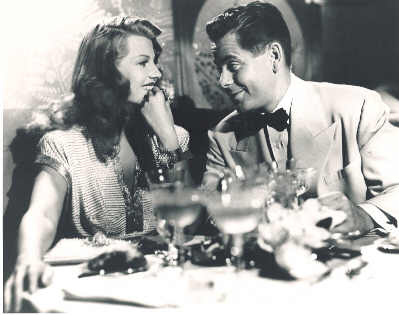
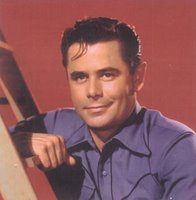
Another screen legend has passed away before the Academy ever got around to lauding him with an honorary Oscar. Glenn Ford was 90. Ford, really one of the most underrated of actors, had a long career, often in Westerns, but appeared in several notable films. He made his film debut in 1937 in a movie called Night in Manhattan, appearing under the name Gwyllyn Ford. Most of his early career was spent in Westerns but his real breakthrough came as Johnny Farrell in 1946's classic Gilda opposite Rita Hayworth, giving steel and wit to what could have been the stand noir role of the male dupe. That same year he appeared opposite Bette Davis in A Stolen Life, where Davis played twins and he was a lighthouse inspector on Martha's Vineyard. I've never seen the film, but I remember the spoof of it from The Carol Burnett Show.
He continued to appear in all sorts of genres, including Westerns such as 1955's The Violent Men and detective dramas like Fritz Lang's The Big Heat in 1953. In 1955, he entered the classroom with Sidney Poitier as one of his students in The Blackboard Jungle. In 1956, he starred in Ransom! (later remade by Ron Howard and Mel Gibson), The Fastest Gun Alive and The Teahouse of the August Moon. He had one of his best roles in a rare turn as a bad guy in 1957's 3:10 to Yuma opposite Van Heflin.

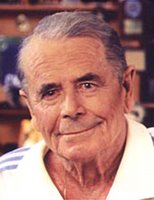
In 1960, he starred in Anthony Mann's remake of the early Oscar-winning best picture Cimarron, which covered more of the Edna Ferber novel. Both films were based on ranging from the Oklahoma Land Run to the Spanish-American War. In 1961, he produced and played against type as The Dude in Frank Capra's A Pocketful of Miracles, an ill-advised remake of Capra's own Lady for a Day. Ford continued to work steadily throughout the 1960s and 1970s, in films such as The Courtship of Eddie's Father, The Rounders and Midway (in Sensurround!) Younger audiences — and given that the film is 26 years old now, that may not even be true — probably recognize him most from playing Pa Kent in 1978's Superman. Unfortunately, that's probably his last notable feature, though he appeared in many television movies, because I think we all should forget his role in the dreadful 1981 slasher flick Happy Birthday to Me.
Read The Washington Post obit here.
Tweet
Labels: Anthony Mann, Bette, Capra, Glenn Ford, Lang, Mel Gibson, Obituary, Poitier, Van Hefiin
TO READ ON, CLICK HERE
Wednesday, August 30, 2006
Centennial Tributes: Joan Blondell
BLOGGER'S NOTE: This is the first in an occasional series marking the 100th anniversary of notable film figures' births. First up, Josh R celebrates Joan Blondell.
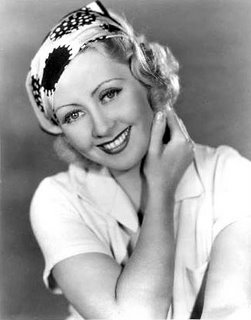
By Josh R
Joan Blondell, who was born Aug. 30, 1906, spent the bulk of her career as a supporting player, usually cast as a brassy but genial confidante. In her best performances — 1945's A Tree Grows in Brooklyn and 1947's Nightmare Alley chief among them — she found a delicate balance between toughness and warmth; in both films, she plays survivors, women who've learned tough lessons in the school of hard knocks, but summon the inner resolve to overcome with their dignity, humanity and humor intact. In the latter film, perhaps the bleakest exercise in film noir to emerge from the studio system (it was judged to be so unsavory in terms of its subject matter that it more or less disappeared for 50 years following its release), she had some startling moments of pain and loss, so that her trademark pluckiness attained the appearance of a necessary defense against the evils of the world. As an over-the-hill vaudevillian eking out a meager living as a bunk artist in a fleabag carnival, she registers all the hurt and humiliation of someone who's been manipulated and betrayed by a callow suitor (an effectively smarmy Tyrone Power). It's her ability to take things in stride, refusing to succumb to bitterness and despair, that turn what could have been a pathetic character into the heart and soul of the film. That's Blondell at her best — very few actresses were able to temper the edginess of such knowing, tough-talking characters with such an unexpected element of tenderness.
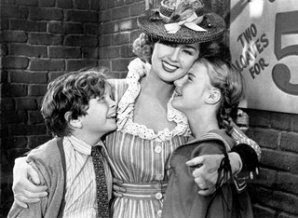
She made a splash on Broadway in the late '20s opposite James Cagney in Sinner's Holiday. Both were brought to Hollywood by Warner Bros., to repeat their performances for the film version. It was 1931's Night Nurse, a Barbara Stanwyck vehicle, that showed how well she played opposite other actresses — a rarity at a time when most female pairings on screen could seem forced or competitive. Time and again she was able to create a natural rapport with her female co-stars, often bringing out the best in them — her scenes with Dorothy McGuire in A Tree Grows in Brooklyn have such a delicate poignancy that it makes the bond between the sisters one of the film's most compelling considerations; it echoes the interplay between Vivien Leigh and Kim Hunter in A Streetcar Named Desire, for which it may, in fact, have been the template — both were directed by Elia Kazan.
She played a few leads, most notably in Gold Diggers of 1933 in which she delivers a memorably torchy rendition of the mournful lament "My Forgotten Man," but she really flourished in sidekick roles opposite more
 glamorous stars. In Desk Set, even Katharine Hepburn seemed to be, for once, as engaged and amused by her female co-star as she was by her leading man (the comic give-and-take between them is seamless). Blondell always seemed more interested in complementing the film's leading lady than in stealing scenes. When she did, it was usually the other actress's fault rather than her own. She had much more natural chemistry with Clark Gable in Adventure than poor Greer Garson could manage — you can practically see Gable heaving a sigh of relief (and becoming more visibly relaxed) when the flouncy blonde enters the room for some appealingly flirty banter. Her only Oscar nomination came in 1951 for The Blue Veil, which gave her a bit more of an edge as a Broadway singer who neglects her young daughter, but still allowed her to inject some much-needed sincerity into an overly maudlin exercise in tear-jerking that otherwise felt rather counterfeit.
glamorous stars. In Desk Set, even Katharine Hepburn seemed to be, for once, as engaged and amused by her female co-star as she was by her leading man (the comic give-and-take between them is seamless). Blondell always seemed more interested in complementing the film's leading lady than in stealing scenes. When she did, it was usually the other actress's fault rather than her own. She had much more natural chemistry with Clark Gable in Adventure than poor Greer Garson could manage — you can practically see Gable heaving a sigh of relief (and becoming more visibly relaxed) when the flouncy blonde enters the room for some appealingly flirty banter. Her only Oscar nomination came in 1951 for The Blue Veil, which gave her a bit more of an edge as a Broadway singer who neglects her young daughter, but still allowed her to inject some much-needed sincerity into an overly maudlin exercise in tear-jerking that otherwise felt rather counterfeit.
She worked steadily right through the 1960s in a variety of character parts that made use of her alternately mischievous and maternal persona. She enjoyed herself as Ladyfingers in The Cincinnati Kid, a role which echoed Zeena from Nightmare Alley without offering her nearly as much to do. Her last major role came for John Cassavetes in 1977's disastrous Opening Night — she was one of the only things in the film that made any sense, and earned a Golden Globe nomination for her efforts. She is best known to the modern generation for her cameo as Vi, the waitress in Grease, offering a sympathetic shoulder to Didi Conn's discouraged beauty school dropout. It was a career full of small gems, consistently enjoyable and eminently worthy of rediscovery.
Tweet
Labels: Blondell, Cagney, Cassavetes, Gable, Garson, K. Hepburn, Kazan, Musicals, Stanwyck, V. Leigh
TO READ ON, CLICK HERE
Tuesday, August 29, 2006
Durang me, Durang me, Ought to take a rope and hang me
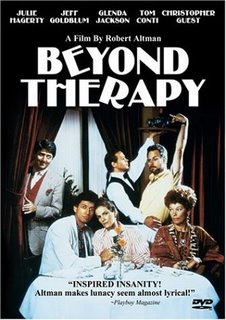
By Edward Copeland
Hang me from the highest tree/Good Lord have pity on me. At least that's how I felt after enduring what takes the title of the absolute worst Robert Altman feature I've ever seen. Altman's 1987 screen adaptation of Beyond Therapy is beyond help — wasting a talented cast that includes Jeff Goldblum, Julie Hagerty, Christopher Guest, Tom Conti and Glenda Jackson in perhaps the worst idea for a play-to-film transfer ever by filming playwright Christopher Durang's equally abysmal play Beyond Therapy to the big screen. Back when the great Frank Rich reviewed theater for The New York Times, he summed up many of the problems with the movie when he reviewed the Broadway transfer of the play in 1981.
"Some day, I swear, the explosive comic brilliance of Christopher Durang will erupt on Broadway. The only question is when. ... (I)t didn't happen last night, when Mr. Durang's latest play, Beyond Therapy, pretty much wilted of its own volition at the Brooks Atkinson."
Both the play and Altman's film allege to be a farce of dysfunctional Manhattanites trying to find love and themselves through personal ads and psychiatry. Goldblum plays Bruce, a bisexual looking to explore hetero life, and Hagerty plays Prudence, a woman "who hates homosexuals" but keeps going back to Bruce anyway. In the middle is Bob, Bruce's gay lover (Guest, developing the prototype for his Corky St. Clair character in Waiting for Guffman) and on the sides are Bruce and Prudence's less-than stellar therapists played by Jackson and Conti, in an awful Italian accent which his character at least admits is a put-on late in the film.
I hate to keep leaning on Rich, but his review of the play said so much that's wrong with Beyond Therapy much better than I ever could.
"It contained some hilarious jokes, uneasily tied to a bland, dramatically amorphous romance ... Yet, for all the hard work, the final result is unchanged. We still don't care whether Bruce ... and Prudence ... ever get married or not. ... At the same time, however, the therapy gags are defeating: like too many jokes in this play, they compromise the credibility of the figures at center stage. ... Mr. Durang's jokey, throw-away rationalizations for this odd courtship provide no enlightenment.
Nor do the other lines fill in the blanks in these people; the playwright never summons up the passion for his leads that he does for their doctors. We're repeatedly told that Bruce must learn to take emotional risks, that Prudence must learn to accept people's imperfections. Both characters are apparently lonely and want children. And that's it. Otherwise, this is a colorless, if whiny, pair who keep coming together and splitting apart as aimlessly as billiard balls.
They remain empty, anonymous vessels for arbitrary one-liners.
Yet the real disappointment in "Beyond Therapy" is the script...
Even though Altman pitched in with Durang for the screenplay, no evidence that it helped appears on the screen. The most positive things I can say about Beyond Therapy is that it's short. I did chuckle once when Bob blames Bruce's exploration of his straight side on seeing that movie Sunday Bloody Sunday with that "English actress" who is of course Glenda Jackson, already trapped in this movie.
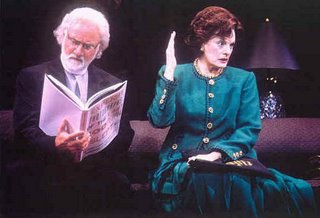 This isn't my first encounter with a wretched work by Durang — I had the misfortune of seeing his play Sex and Longing on Broadway with Sigourney Weaver and it remains the single worst Broadway production I've ever seen. I've not seen Durang's more acclaimed works, but based on these two, my guess is that either he peaked early or that his reputation was overblown to begin with. The only performer to emerge unscathed in Sex and Longing was the great Dana Ivey, who somehow managed a great performance in the slop of a script she was performing, something unfortunately none of the cast of the Beyond Therapy film were able to accomplish. I don't know what attracted Altman to film this piece of dreck, but I do think it's telling that it's one of the few DVDs of an Altman feature that contains neither a commentary track by the director nor a featurette where he talks about the film. Maybe Altman knows it's better to let this one slip away. Now that I've seen it, I'm inclined to agree. I guess I really have been too hard on Quintet, Ready to Wear and Dr. T. and the Women.
This isn't my first encounter with a wretched work by Durang — I had the misfortune of seeing his play Sex and Longing on Broadway with Sigourney Weaver and it remains the single worst Broadway production I've ever seen. I've not seen Durang's more acclaimed works, but based on these two, my guess is that either he peaked early or that his reputation was overblown to begin with. The only performer to emerge unscathed in Sex and Longing was the great Dana Ivey, who somehow managed a great performance in the slop of a script she was performing, something unfortunately none of the cast of the Beyond Therapy film were able to accomplish. I don't know what attracted Altman to film this piece of dreck, but I do think it's telling that it's one of the few DVDs of an Altman feature that contains neither a commentary track by the director nor a featurette where he talks about the film. Maybe Altman knows it's better to let this one slip away. Now that I've seen it, I'm inclined to agree. I guess I really have been too hard on Quintet, Ready to Wear and Dr. T. and the Women.Tweet
Labels: 80s, Altman, Jeff Goldblum, Sigourney Weaver, Theater
TO READ ON, CLICK HERE
Monday, August 28, 2006
Elegy for Deadwood
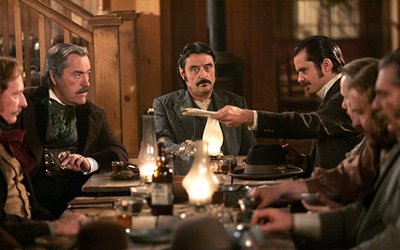
Al Swearengen

By Edward Copeland
Alas, all Deadwood fans will have to start learning to dance today without David Milch's great Western in our lives and on HBO. Sure, it seems likely that sometime next year, they'll throw us a bone with two, two-hour movies to try to wrap up the story, but it's still sad to imagine that there won't be any more full-fledged seasons of Deadwood. Without giving away anything that transpired in the final episode, it seemed anticlimactic to me. The tension that had been building over the past few episodes didn't seem to lead to a rousing finish and I guess now it can't. It took me awhile to warm to Deadwood. For about the first four or five episodes of the first season, I'd ask myself after each new episode, "Did I like that?" Robin Weigert's performance as Calamity Jane drove me up the wall. Then, suddenly — and I wish I could pinpoint the exact moment — it won me over.
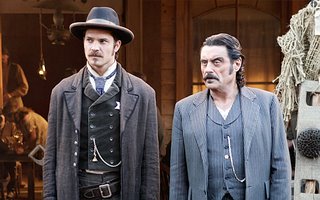
Ever since, the series has just grown better and better in my mind. Weigert also seems to have toned down her performance to the point that not only could I tolerate her I even grew to — gasp — like her. While it's true, this season did have its flaws — I think it was trying to keep too many balls in the air at once to do justice to them all and some stories didn't seem to amount to much. Was there really a point to the brief appearance of the Earp brothers (Gale Harold, Austin Nichols) in the camp? Aunt Lou (Cleo King) and Odell (Omar Gooding) showed promise, but that too seemed to go nowhere. I'm still not seeing why we needed to spend so much time on Langrishe (Brian Cox) and his acting troupe, but I suspect we would have if we'd been given the fourth season we deserve. I also bet truncated, two two-hour movies won't be enough time to justify their presence either, but hopefully Milch will prove me wrong.
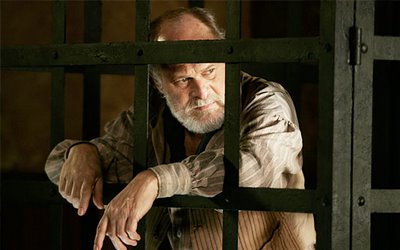
The star of season 3 though was undoubtedly Gerald McRaney and his portrayal of the frightening George Hearst. Who knew that the star of Major Dad and Simon and Simon had this great a performance in him or that he'd give the incomparable Ian McShane a run for his money as the series' best performance? It takes a lot — great writing and great acting — to create a character that makes Al Swearengen quake. When Trixie (Paula Malcolmson) gave Hearst a flesh wound last week, it was such a vicarious thrill because Hearst had earned that and more. Historical accuracy be damned — I don't care that he was a real person who didn't die in Deadwood, someone should have whacked this prick a long time ago. In the finale, McRaney got one of the best lines when he tells Bullock (Timothy Olyphant) that he's having a conversation "that only I can hear."
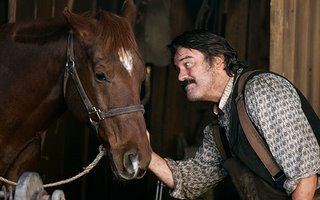
One aspect of Deadwood that I feel always gets short shrift is its humor — and there was plenty this season, such as Steve the drunk (Michael Harney) and his adventures with the horse. At times, the many scenes involving him seemed like a distraction, but it was all worth it to see Franklin Ajaye as the Nigger General cart Steve in his vegetative state around to voting booths and bars, even to the amateur night
 put on by the Langrishe troupe, perhaps the best use of the theater company's story that appeared all season. Of course, any scene involving Al and Wu (Keone Young) always was good for some laughs, but for me there was a breakout star other than McRaney that really took flight this season and that is Ralph Richeson as Richardson, E.B. Farnum's slow-witted man Friday. I don't know where they found Richeson, but the expansion of his role this season has been a delight, from his constant playing with the antlers on the walls of the hotel to his delivery of messages for Farnum and finally his display of juggling prowess on amateur night which Farnum unfortunately cut short. William Sanderson's Farnum always is amusing, but Richardson is hysterical and the finale gives him some great final scenes. Cheers to Richeson and Richardson. I may miss them most of all.
put on by the Langrishe troupe, perhaps the best use of the theater company's story that appeared all season. Of course, any scene involving Al and Wu (Keone Young) always was good for some laughs, but for me there was a breakout star other than McRaney that really took flight this season and that is Ralph Richeson as Richardson, E.B. Farnum's slow-witted man Friday. I don't know where they found Richeson, but the expansion of his role this season has been a delight, from his constant playing with the antlers on the walls of the hotel to his delivery of messages for Farnum and finally his display of juggling prowess on amateur night which Farnum unfortunately cut short. William Sanderson's Farnum always is amusing, but Richardson is hysterical and the finale gives him some great final scenes. Cheers to Richeson and Richardson. I may miss them most of all.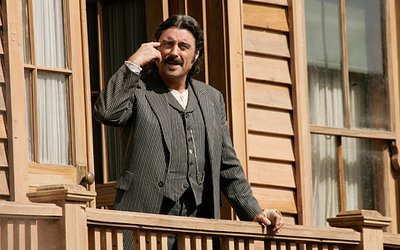
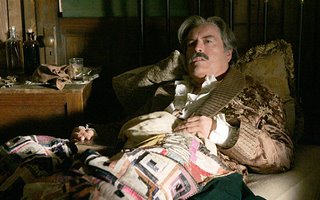
Of course, I exaggerate — because one actor and character single-handedly secured my interest in this show and held my interest from beginning to end, whether he was inflicting brutality, being brutalized, fighting kidney stones or even singing a solitary song with no one around. Ian McShane's Al Swearengen is one of the most brilliant fusions of actor and character in the history of television. The finale even gave him one last, albeit brief, monologue to the box containing the Indian's head. Coming the day after the Emmys, it remains an outrage that McShane didn't receive an Emmy nomination for the first season and a bigger one that he didn't win for season two. Don't fuck it up next year you Academy of Television Arts & Sciences cocksuckers — and you better remember Gerald McRaney as well. Deadwood will be missed — in fact I feel like Cy Tolliver (Powers Boothe) does in this photo following his stabbing by Andy Cramed (Zach Grenier), the gambler he left to die in the woods but who survived and came back as a vengeance-seeking minister at the end of Season 2.
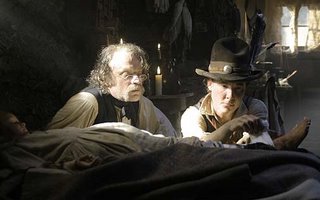
Thank goodness The Wire returns soon — because both shows, while residing in different centuries and universes, share one aspect in common — they challenge the audience. You can't be casual viewers of either show and you have to pay attention to keep up with what each show is doing, be it in the florid language of Milch's denizens of Deadwood or the varied vernaculars of Baltimore. Both simply are the best in television drama. I may need to seek Doc (Brad Dourif) to treat my illness I've contracted from the premature demise of Deadwood, assuming Doc doesn't succumb to TB first (and where the hell was he in the last episode anyway?) As much as I love The Sopranos, it doesn't require the close attention Deadwood and The Wire do as both series keep upping the stakes and growing more complex and satisfying with each passing season. The Sopranos really hasn't surpassed the plateau of excellence it reached back in season 3. On top of that, The Sopranos has sapped the goodwill of its fans with its overindulgent hiatuses. Following the insanely long break between season 5 and season 6 of The Sopranos, the quality of the show couldn't overcome the interest lost during its long absence. I still will eagerly await its conclusion next spring, but I don't think I'll miss it the way I will Deadwood or, eventually, The Wire. In fact, as a precaution, I'm beginning to build a time machine so I can bring Trixie and her derringer back to try to influence the folks at HBO to come up with another season of Deadwood or, at the very least, to ensure that David Simon gets the fifth and final season of The Wire he has in mind.
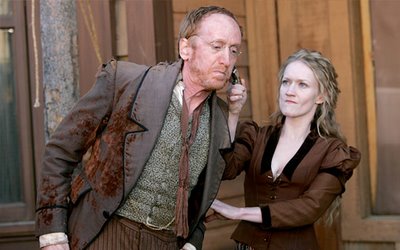
Tweet
Labels: David Simon, Deadwood, HBO, Milch, The Sopranos, The Wire, TV Tribute
TO READ ON, CLICK HERE
Friday, August 25, 2006
From the Vault: Haskell Wexler
This interview with Oscar-winning director of photography and director Haskell Wexler was originally published in two parts in 1990.
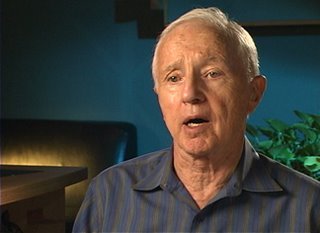
When Haskell Wexler answered question from a crowd of about 100 people following a screening of his film Medium Cool, he relayed a story about his days as a merchant seaman. He told how he used to annoy colleagues with his views of how he'd change the world to which they'd respond, "What do you know about changing the world? You can't even tie a bolo."
Wexler used this story as a metaphor about professionalism, which he called "the disease of our times." Wexler worries that because of this "disease," film schools have turned into "vocational school on how to adapt to the system."
"It's important to know what to do with your art, not how to do it," Wexler said, making the point that would-be filmmakers need to decide if they want their work to be "pure" as intended to a smaller audience or to make a hit based on viewer response.
He spoke about Dead Poets Society, which he said was "good, but not great" but did attempt to say something about life, ideal and art.
"It helps that it made money. Each one that makes money makes another film like it easier to make."
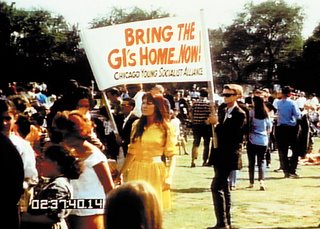
Wexler blamed many of the problems on the corporate system of Hollywood, though he did say that any artist can persevere if he "pushes the limits of his artistic control."
In that general area, he point to the double standard in censorship attempts and the recent ratings controversy over The Cook, the Thief, His Wife and Her Lover and Wild Orchid.
The MPAA threatened both films with X ratings but Orchid was re-cut to receive an R and Cook went out unrated.
"Smart people are destroying the world everyday and that's not obscene but you say fuck and it is dirty, obscene and awful."
As far as films themselves, Wexler pointed to Driving Miss Daisy as his favorite film of last year because of its "humanity" and "quietness." As for personal influences, Wexler cited Jean-Luc Godard as having a major effect on his style as a director. He also named the late Hal Ashby, whom Wexler worked with on Bound for Glory and Coming Home, as the best director he ever worked for.
"At his best, Hal was extremely creative and socially aware."
He also defended Oliver Stone, the Oscar-winning director of Born on the Fourth of July, who has received criticism for scenes in the biopic that didn't really happen. Stone claimed he used "creative license to tell a bigger truth."
"I know Ron Kovic and I read the book and the film is in essence true, if not in specifics...the feeling for the time is very accurate."
Most recently, Wexler worked on The Two Jakes, the long-awaited sequel to Chinatown as a favor to director/star Jack Nicholson, whose original cinematographer had to leave to fulfill a prior commitment on Brian De Palma's The Bonfire of the Vanities.
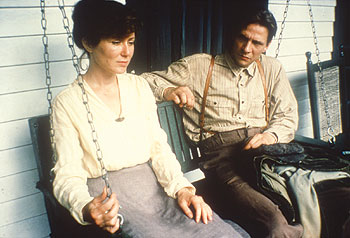
Haskell Wexler won Oscars for cinematography for Who's Afraid of Virginia Woolf? and Bound for Glory. He also has worked as a director on politically charged documentaries and fiction films such as Medium Cool and Latino.
Wexler began working as a d.p. in features in 1958 with Stakeout on Dope Street, the directing debut of Irvin Kershner (The Empire Strikes Back).
Most recently, he received an Oscar nomination and won the American Society of Cinematographers' award for Blaze.
"I was so afraid that I would win this year because I had absolutely no idea what to say. I was so relieved when Freddie (Francis, d.p. on Glory) won."
Wexler said that, in addition to the positive results an Oscar can bring, it also gets the winner calls from people they haven't heard from in years seeking help or money.
The director of photography is responsible for the recorded image a film presents. The d.p. is "the director's right hand," helping with composition, camera movement and location in addition to managing the technical crews from electricians to grips.
Wexler, being one of the top cinematographers in the business, gets his pick of projects, though restlessness and the need for his crew to work often become a factor. As a d.p., Wexler receives an asking price of $12,000 a week plus expenses for a five-day week, far below what actors, directors and screenwriters earn for their work in the collaborative medium.
As far as personal satisfaction with his work, Wexler cited Elia Kazan's 1963 black-and-white America, America as the film in which he's proudest of its look, followed by 1987's Matewan, the John Sayles' movie which Wexler proudly wore a jacket from during his trip here.
Wexler spoke of his concern about the "100 percent film student" who knows no difference between the real world and what's on the screen.
"It's very secure to have your world history on video...if you think people smoke, drink and make love or dress the way they do in films, you have a problem."
Tweet
Labels: Ashby, De Palma, Godard, Interview, Kazan, Nicholson, Oliver Stone, Oscars, Sayles, Wexler
TO READ ON, CLICK HERE
Wednesday, August 23, 2006
When the Levees Broke, Acts III and IV

"We are destroyed. I've seen Beirut. I've seen Calcutta. I've seen downtown Jakarta. I've seen Aceh.
They have nothing on us."
Garland Robinette, radio host and resident of Uptown

By Edward Copeland
Building on what he started in the first half of his documentary When the Levees Broke: A Requiem in Four Act, Spike Lee brings home the human and emotional toll in Acts III and IV. Some of the political bungling detailed in Acts I and II are still present — Dubya takes hits for failing to arrive on the scene of the disaster until weeks after it occurred and then sapping the already fragile electrical services to power his photo op. Still, most of the HBO documentary's second half concentrates on the devastation, both physical and human.
A doctor reports the startling rise in what can only be classified as post-traumatic stress disorder among the survivors. Louisiana's state medical examiner discusses the number of Katrina-related deaths that can't be classified as such because they weren't directly caused by the hurricane, ranging from suicides to suspended cancer treatments. The film also shows the families ripped apart, with rescues that would whisk moms to Utah while their children went to Texas. Some New Orleans residents remain determined to return while others have no intention of heading back to a city that was fairly dysfunctional even before the storm. If Lee makes a misstep in the documentary, it is the inclusion of a brief segment about the cultural traditions of New Orleans, wholly appropriate to the discussion, but which seems out of place stuck in the middle of Act III. It plays like an excuse to have Lee's frequent composer and New Orleans resident Terence Blanchard walk through the rubble playing his trumpet. It would have been better to have placed this sequence either early in the first half or perhaps at the beginning of Act IV, which shows this year's Mardi Gras celebration giving the city a badly needed boost of energy of hope.
Mardi Gras not only rejuvenated the dispirited residents, the footage of the festivities also provides viewers of the documentary a much-needed respite from the sadness and horror evoked by the tragedy. My favorite sight: a reveler wearing a T-shirt which reads, "FEMA EVACUATION PLAN: Run Motherfucker Run." Perhaps Mardi Gras is the best medicine.
"It was as if I'd walked through a time warp and I was in Europe following a bombing in World War II. Everything was gray. There was no green, no flowers, no birds, no dogs, no people, no children."
Louella Givens, an attorney and Lakeshore resident

The relief offered by the Mardi Gras sequence doesn't last, preceding some of Lee's strongest emotional punches to the gut, detailing the true human toll of the incompetence and indifference of FEMA and the Army Corps of Engineers. The Corps, who built the poorly designed levees that led to the deluge that devastated the city, also was assigned the task of removing the piles of debris — only they didn't show up until four months after the hurricane hit. One lawyer suggested suing the Corps for causing the calamity, but found they are legally immune from lawsuits. He turned to suing the insurance industry that went out of its way not to pay off people's claims, a suit in which the insurers recently won a court victory. Other stories that break your heart are the tales of how crews responsible for marking houses as having been searched and finding no bodies did a half-assed job that ended up with people discovering the corpses of their loved ones as many as months later. On top of that tragedy, official identification of the dead was delayed by a lack of funding for the state ME's office to conduct DNA tests, funds he requested in September 2005 but didn't receive until December. As the first anniversary approaches next week, bodies still turn up, debris still stands and residents remain homeless, waiting for help that an Associated Press story released last night reports Louisiana state officials still haven't distributed. Spike Lee's masterwork reminds you of the anger and heartache many, even those not directly affected by Katrina, felt as they watched the events unfold on television. As one resident says, it wasn't just the levees that broke, so did people's spirits, but as the Mardi Gras celebration shows, healing can begin even under the worst of circumstances.
Tweet
Labels: 00s, Documentary, HBO, Spike Lee, Television
TO READ ON, CLICK HERE
Tuesday, August 22, 2006
When the Levees Broke, Acts I and II
"You had to have your heart broken if you love this country and watched the slow federal response to Katrina."
Historian Douglas Brinkley

By Edward Copeland
Almost exactly a year after Hurricane Katrina devastated New Orleans and the Gulf Coast, it's easy to forget how sad and angry watching the crisis unfold left you — especially with all the new outrages, examples of government incompetence and personal losses we've endured in the interim. That's what makes Spike Lee's excellent HBO documentary When the Levees Broke: A Requiem in Four Acts all the more timely — so we don't forget the emotions last year's cataclysm evoked.

Acts I and II aired last night. The final two acts will air tonight. The way Lee has constructed his film, your anger bubbles and bubbles and bubbles as the documentary progresses — and I've only seen half of it so far. I can't imagine how I'll feel by the film's completion tonight. Lee approaches the material in a straight-forward way, interspersing footage from last year's events with countless interviews with officials, experts and New Orleans residents offering witness testimony. There needn't be flashy tricks or stacking the deck in order to rile viewers — the scenes and the testimony make the case for the amazing human toll wrought by this weather disaster and the failures on all levels of government to respond quickly and effectively to the pleas for help. Rhetoric is unnecessary when you see the harrowing rescues from flooded attics and the haunting images of corpses floating in the flood waters.

What's most remarkable about the first half of Lee's documentary are the facts and anecdotes that were new to me, especially when you learn how the exaggerations and rumors of crime and government-dynamiting of the levees began, some dating back as far as massive New Orleans flooding that occurred in 1927. There's also more insight into the political infighting between Louisiana Gov. Kathleen Blanco and New Orleans Mayor Ray Nagin: Nagin endorsed the GOP candidate for governor, now-Sen. Bobby Jindal, when he ran against Blanco and Blanco still nursed the grudge, even when it got in the way of helping the citizens of Louisiana. Of course, the biggest outrages fall on federal shoulders as FEMA Director Michael Brown gets in over his head and Dubya plays air guitar while New Orleans burns. As Robert Rocque, a resident of New Orleans' devastated lower ninth ward observes, Bush is the "type of person who gives C students around the world a bad name."
In the end (at least of the first half), When the Levees Broke is less about fingerpointing and placing blame than leaving a historical record of the disaster for future generations to see. It seems wrong to say I'm looking forward to watching Acts III and IV tonight — this isn't a movie you watch for entertainment, it's one you watch for edification and if the first half is any indication, the entire piece will prove a lasting landmark.
Tweet
Labels: 00s, Documentary, HBO, Spike Lee, Television
TO READ ON, CLICK HERE
Sunday, August 20, 2006
Tony Jay (1933-2006)
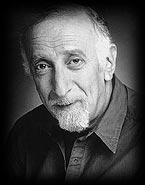
The name might not ring a bell and even his photo might not stir much in the way of recognition, but you certainly know Tony Jay's voice. The actor has died from complications of lung cancer. You might recognize him from recurring roles on TV's Beauty and the Beast or Lois & Clark: The New Adventures of Superman, but for me I'll always remember his three episodes of Twin Peaks as Dougie Milford, the estranged brother of the decrepit Mayor Milford who died in his honeymoon bed at the Great Northern with his young bride Lana (Robyn Lively). Not being a video game player, I'm not familiar with his plentiful work there, but I certainly recall his distinctive baritone voice, often used as a narrator, and most notably as Judge Frollo in Disney's animated The Hunchback of Notre Dame.
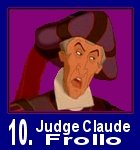
By Valerie J. Nelson
Times Staff Writer
August 20, 2006
Tony Jay, a voice actor who was best remembered for playing the elegantly malevolent Judge Frollo in the animated Disney film The Hunchback of Notre Dame and whose deep baritone frequently heightened the drama in video games, has died. He was 73.
Jay, who was heard in many commercials and cartoons, died Aug. 13 at Kindred Hospital in Los Angeles from complications after surgery in April to remove cancer from his lungs, said his wife, Marta MacGeraghty Jay.
The role of Quasimodo's guardian was "a gift," Jay said when the 1996 movie was released. "It's my bid for immortality."
The Times review by Kenneth Turan said the veteran British actor had "perfectly voiced" the part of the evil Frollo who lusted after Esmeralda, a part spoken by Demi Moore.
Tweet
Labels: Animation, Demi, Disney, Obituary, Twin Peaks
TO READ ON, CLICK HERE
Thursday, August 17, 2006
Altman meets Sam Shepard

By Edward Copeland
Seinfeld always was classified as a show about "nothing" and for the first hour and 15 minutes, I was prepared to give that label to Robert Altman's film version of Sam Shepard's Fool for Love, minus the consistent laughs. Then, suddenly in the final 30 minutes, the movie comes to life — though it's still unclear what it's about and it's too late to save it.
Based on Shepard's play, in simple terms, Fool for Love concentrates on four characters at a desolate New Mexico motel. There is Eddie (Sam Shepard), a cowboy who seems intent on causing trouble for May, one of the hotel's tenants (Kim Basinger). There also is the old man who runs the motel (Harry Dean Stanton) and Martin (Randy Quaid), who arrives expecting a date with May.
I've enjoyed Shepard's plays, particularly Buried Child and True West, but Fool for Love seems particularly aimless. At one point, as Eddie is trying to finish a story about him and May (which may or may not be true), May accuses him of repeating himself. Eddie insists he never repeats himself, but May begs to differ, saying he always goes around in circles, never getting anywhere.
That's pretty much how the movie works, spinning forward without any sense of direction. May asks Eddie what the point of his story is and Eddie even admits it's pointless.
Fool for Love came out in 1985, when Altman was in a cycle of filming plays for both film and television. I haven't seen Come Back to the Five and Dime, Jimmy Dean, Jimmy Dean or his network production of The Caine Mutiny Court-Martial, but Fool for Love certainly pales next to Streamers, Secret Honor and The Laundromat for HBO.
Shepard, Stanton and Quaid are all good, but Basinger struggles mightily with her southwestern accent.
In a note on the DVD, Altman tells viewers he always was puzzled by people's reaction to stage versions of Fool for Love, asking if they saw the same play he saw. The movie begs the question what exactly it was that Altman saw.
The last half hour has its moments, but it's slowgoing getting there and the final product really doesn't add up to much.
Tweet
Labels: 80s, Altman, HBO, R. Quaid, Seinfeld, Shepard, Theater
TO READ ON, CLICK HERE
Wednesday, August 16, 2006
Bruno Kirby (1949-2006)
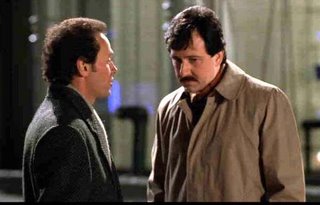
Some celebrity deaths take you by surprise and that is certainly the case with Bruno Kirby, who died Monday from leukemia. It seems as if Kirby has been around forever, popping up in various movies and TV shows (sometimes credited as Bruce Kirby Jr. or B. Kirby in his early days).
One of his first credits at the Internet Movie Database is the pilot episode of TV's M*A*S*H but he was also a semi-regular on Room 222 and appeared on other 1970s series such as Columbo, Kojak and Emergency! However, it's his film work that most people, including myself will recall.
From his appearance as one of the students in the supremely goofy and dated The Harrad Experiment in 1973 to his role as the young Clemenza opposite Robert De Niro's young Vito Corleone in The Godfather Part II. Still, Kirby didn't really hit his film stride until the 1980s, appearing in Albert Brooks' Modern Romance, This Is Spinal Tap and Birdy among others. He also worked three times in films with director Barry Levinson in Sleepers, Tin Men and Good Morning Vietnam. He teamed twice with Billy Crystal in When Harry Met Sally and City Slickers, the films that cemented his sardonic screen persona.
He wasn't just about comedy though — he also played the closeted coach in The Basketball Diaries and appeared in Donnie Brasco as well. For me, my favorite film role of Kirby's is as Marlon Brando's nephew in the great comedy The Freshman, so in a way you can say Kirby played opposite both Vito Corleones.
Still the strongest memories for me of Kirby may very well be his work in two television series. First, in the "Gas Man" episode of Homicide: Life on the Street, also directed by Levinson, where he played a man newly released from prison for causing an accidental poisoning death and determined to get revenge on Detective Frank Pembleton (Andre Braugher), the cop who put him behind bars, with the reluctant help of his friend (Richard Edson).
His first television work with Garry Shandling came in the last two seasons of "It's Garry Shandling's Show." where he played Garry's manager Brad Brillnick, but the more lasting and hysterical collaboration with Shandling came with Kirby frequently playing himself on The Larry Sanders Show as a guest who constantly gets bumped when the show goes long.
Tweet
Labels: Albert Brooks, B. Levinson, Brando, Braugher, De Niro, Homicide, Larry Sanders, Obituary, Shandling, Television
TO READ ON, CLICK HERE
Monday, August 14, 2006
When Oscar Drops the Ball
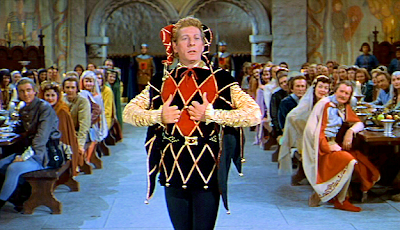
By Josh R
Josh R here — after several weeks without full Internet access (and a new computer that’s been a problem child), I’ve decided to celebrate my return to cyberspace by resuming one of my favorite pastimes: Oscar-bashing. As we all know, the year’s best performances usually go home empty handed — quite often, they aren’t even nominated. I decided to try to pick out the 20 most (to borrow a phrase from Dame Julie Andrews) egregiously overlooked performances in the history of the Academy Awards — the kind of omissions that just make you scratch your head, if not bang it against the wall out of sheer frustration.
Entertainment Weekly attempted something like this a year or two ago — I believe their list went all the way up to 100 — and the results ranged from the obvious and expected to the puzzling and obscure. I’m not sure if there’s anything on my list that wasn’t included on theirs (I don’t have it in front of me to cross-reference), but I’m not going to make any strained effort at originality; all of the performances cited are, I imagine, ones that most of the visitors to this site will be familiar with, if not through first-hand viewing experience, than certainly by reputation. If this doesn’t exactly reflect what I think the best unnominated performances of all time are in the strictest of order, it’s because, in the interest of fairness, I’ve decided not to cite any individual actor more than once — if I’d chosen to do otherwise, the performances of Cary Grant and Humphrey Bogart alone might have accounted for at least 25% of what emerged from the elimination process.
Needless to say, paring down the list turned out to be very, very tough — there were a lot of painful cuts I had to make, but in the interest of time and space (and in order not to try Mr. Copeland’s patience more than I had to), I was determined to limit myself to 20. This has resulted in some bruised feelings in several quarters — No. 21, Danny Kaye from The Court Jester, still isn’t returning my phone calls. Based on the elimination process, I would not have difficulty finding enough performances to fill out a top 100, and might even make it to 200 if sanity would allow. My natural preference for older films will be is very much in evidence — the closest any “contemporary” performance came to making the cut was Gene Hackman for The Conversation — and only one of the performers cited is, in fact, still living. Feel free to agree or disagree with my choices, and mention any that you feel ought to have been included.
I realize that there are some purists out there who believe that Oscars should only be awarded for what falls under the traditional definition of “great acting” — that is to say, how an actor inhabits a role, how convincing or life-like they are as the character, how they
 express themselves through their delivery of dialogue, outward displays of emotion, physical transformation, etc. I can’t fully agree with that assessment — if you want to be technical about it, the category is best performance by an actor in a lead or supporting role, and that term encompasses a whole lot more than what falls under the narrow definition outlined above. When people say that Mikhail Baryshnikov gave one of the greatest performances they’ve ever seen in Balanchine’s production of Swan Lake, or Jessye Norman in the title role in Tosca, they’re not talking about their acting, at least not in terms of what it is that makes the performance great. That being the case, I can say without hesitation that in Singin’ in the Rain, Gene Kelly gives one of the best, most skillful and most enjoyable performances in the history of motion pictures. For the record, I also think he does a good acting job, which is only incidental to what qualifies this performance for a mention on this list. Singin’ in the Rain represents Kelly at the pinnacle of his powers — the most complete and virtuosic demonstration of his ability and craft. Watching him dance the extended Broadway Rhythm ballet, lending his light, supple tenor to “You Were Meant for Me” or “You Are My Lucky Star,” navigating Hollywood traffic to get to Debbie Reynolds’ car with deftly executed acrobatics, or best of all, singing and dancing in the rain, is to understand what made Kelly one of the greatest talents the cinema has ever produced. The title number may be the purest expression of joy ever captured on film — a moment of unabashed euphoria that communicates more about the experience of being in love than anything any other actor could do with pages of dialogue. It is Kelly’s crowning achievement as an artist, and it deserved — at the very least — a nomination.
express themselves through their delivery of dialogue, outward displays of emotion, physical transformation, etc. I can’t fully agree with that assessment — if you want to be technical about it, the category is best performance by an actor in a lead or supporting role, and that term encompasses a whole lot more than what falls under the narrow definition outlined above. When people say that Mikhail Baryshnikov gave one of the greatest performances they’ve ever seen in Balanchine’s production of Swan Lake, or Jessye Norman in the title role in Tosca, they’re not talking about their acting, at least not in terms of what it is that makes the performance great. That being the case, I can say without hesitation that in Singin’ in the Rain, Gene Kelly gives one of the best, most skillful and most enjoyable performances in the history of motion pictures. For the record, I also think he does a good acting job, which is only incidental to what qualifies this performance for a mention on this list. Singin’ in the Rain represents Kelly at the pinnacle of his powers — the most complete and virtuosic demonstration of his ability and craft. Watching him dance the extended Broadway Rhythm ballet, lending his light, supple tenor to “You Were Meant for Me” or “You Are My Lucky Star,” navigating Hollywood traffic to get to Debbie Reynolds’ car with deftly executed acrobatics, or best of all, singing and dancing in the rain, is to understand what made Kelly one of the greatest talents the cinema has ever produced. The title number may be the purest expression of joy ever captured on film — a moment of unabashed euphoria that communicates more about the experience of being in love than anything any other actor could do with pages of dialogue. It is Kelly’s crowning achievement as an artist, and it deserved — at the very least — a nomination.Spencer Tracy was, in fact, nominated for best actor in 1958 — for his performance in an adaptation of Ernest Hemingway’s The Old Man and the Sea that managed to be both trite and stuffy at the same time. Right actor, right year…wrong performance. In John Ford’s
 The Last Hurrah, Tracy is at his most engaged and assured — the role of an old-school, slightly shady machine politician, a shambling Irishman with a bit of the blarney in him, fits the actor like a well-worn glove, giving the Golden Age’s great naturalist the chance to show his full range. It’s a truly layered performance — irascible and slyly comic in one moment and frail and heartbreaking in the next, Tracy shows how the hyper-energized drive and charisma of an dynamic, outsized personality exists at painful odds with the weariness and strain of a body that can no longer comfortably accommodate such attributes. Several of Tracy’s 10 nominations seem more like ceremonial gestures made out of respect for the actor’s reputation than anything else — which is to say, all but a few seem to be based on the merits of the actual performances. Apart from the Hemingway adaptation, his four final best actor nominations came for playing grand old men delivering high-minded sermons; at some point, he stopped being an actor and became the nation’s conscience. The Last Hurrah brought out the mischief and the sadness in Tracy that few of his other later roles allowed him to express — it’s his most human and humane work as an actor.
The Last Hurrah, Tracy is at his most engaged and assured — the role of an old-school, slightly shady machine politician, a shambling Irishman with a bit of the blarney in him, fits the actor like a well-worn glove, giving the Golden Age’s great naturalist the chance to show his full range. It’s a truly layered performance — irascible and slyly comic in one moment and frail and heartbreaking in the next, Tracy shows how the hyper-energized drive and charisma of an dynamic, outsized personality exists at painful odds with the weariness and strain of a body that can no longer comfortably accommodate such attributes. Several of Tracy’s 10 nominations seem more like ceremonial gestures made out of respect for the actor’s reputation than anything else — which is to say, all but a few seem to be based on the merits of the actual performances. Apart from the Hemingway adaptation, his four final best actor nominations came for playing grand old men delivering high-minded sermons; at some point, he stopped being an actor and became the nation’s conscience. The Last Hurrah brought out the mischief and the sadness in Tracy that few of his other later roles allowed him to express — it’s his most human and humane work as an actor.He was known for most of his career as The Profile — a giant of the stage and an iconic figure of celebrity who never fully found his
 bearings on film. He was never nominated for an Oscar, despite several successful films and a measure of standing within the film community. Truth be told, he was more than a bit past his prime by the time the medium of film came into its own, and was mostly content to coast on his reputation. At least once in the sound era, he did rise gloriously to the occasion, in a role that made full and hilarious use of his theatrical brio and larger-than-life persona. In Twentieth Century, Barrymore is pure ham — narcissistic, domineering, pompous, preening, more than slightly crazed and wickedly, wickedly funny. His Oscar Jaffe, a theatrical impresario trying to con his wayward protégé into coming back to him, has the bulging, burning eyes of a man possessed, the twisted Machiavellian grin of a cat eyeing the canary, and the ridiculously florid cadence of someone for whom the concept of going over the top exists only in theory — he’s a daffy Rasputin whose cunning and wit become even sharper with each additional marble he loses. Watching him and the peerless Carole Lombard driving each other into fits of hysteria with endlessly inventive bits of comic business is a wonder to behold.
bearings on film. He was never nominated for an Oscar, despite several successful films and a measure of standing within the film community. Truth be told, he was more than a bit past his prime by the time the medium of film came into its own, and was mostly content to coast on his reputation. At least once in the sound era, he did rise gloriously to the occasion, in a role that made full and hilarious use of his theatrical brio and larger-than-life persona. In Twentieth Century, Barrymore is pure ham — narcissistic, domineering, pompous, preening, more than slightly crazed and wickedly, wickedly funny. His Oscar Jaffe, a theatrical impresario trying to con his wayward protégé into coming back to him, has the bulging, burning eyes of a man possessed, the twisted Machiavellian grin of a cat eyeing the canary, and the ridiculously florid cadence of someone for whom the concept of going over the top exists only in theory — he’s a daffy Rasputin whose cunning and wit become even sharper with each additional marble he loses. Watching him and the peerless Carole Lombard driving each other into fits of hysteria with endlessly inventive bits of comic business is a wonder to behold.Bette Davis was just a run-of-the-mill contract player of (what was judged to be) average ability until she landed the role that put her on the map — and it was a role than nobody else wanted. Every major star in town passed on the project, and given the nature of the
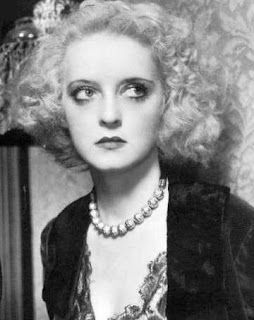 material, it’s little wonder. Crass, trashy, thoroughly unremarkable in any respect other than her utter lack of sensitivity, the character of Mildred in Somerset Maugham’s Of Human Bondage was the kind of blatantly unsympathetic role that looked and smelled like a career-killer. No shrinking violet, Davis saw it as a golden opportunity, and convinced Jack Warner (over his objections) to let her do it. The results were so startling and unnerving that they forever changed the rules for actresses in Hollywood. Screen heroines of the '20s and '30s were affected and refined — even the bad girls never succumbed to total ugliness, or raised their voices beyond a respectable decibel level. Such was the conviction and raw energy that Davis brought to her performance that it must have landed like a shovel to the stomach for audiences of the time. It still does. The actress didn’t allow vanity or caution to temper her portrayal of the role — her cockney tart is stupid and vulgar, an altogether ordinary woman incapable of any thought or feeling beyond her own narrow self-regard. She’s a nightmare version of Eliza Doolittle as imagined by Zola, only barely a level or two on the evolutionary ladder above grisly creatures risen from prehistoric muck….you can understand why Leslie Howard’s wimpy masochist doesn’t stand any kind of a chance against her. When he finally tries to break free of her clutches, Davis unleashes a raw working of anger and hostility unlike virtually any ever attempted on film. Contorting her face and body like a rabid dog pouncing on its prey while the bile issues forth from her twisted mouth, you cower in your seat at the sheer volcanic force of it. Only you can’t look away.
material, it’s little wonder. Crass, trashy, thoroughly unremarkable in any respect other than her utter lack of sensitivity, the character of Mildred in Somerset Maugham’s Of Human Bondage was the kind of blatantly unsympathetic role that looked and smelled like a career-killer. No shrinking violet, Davis saw it as a golden opportunity, and convinced Jack Warner (over his objections) to let her do it. The results were so startling and unnerving that they forever changed the rules for actresses in Hollywood. Screen heroines of the '20s and '30s were affected and refined — even the bad girls never succumbed to total ugliness, or raised their voices beyond a respectable decibel level. Such was the conviction and raw energy that Davis brought to her performance that it must have landed like a shovel to the stomach for audiences of the time. It still does. The actress didn’t allow vanity or caution to temper her portrayal of the role — her cockney tart is stupid and vulgar, an altogether ordinary woman incapable of any thought or feeling beyond her own narrow self-regard. She’s a nightmare version of Eliza Doolittle as imagined by Zola, only barely a level or two on the evolutionary ladder above grisly creatures risen from prehistoric muck….you can understand why Leslie Howard’s wimpy masochist doesn’t stand any kind of a chance against her. When he finally tries to break free of her clutches, Davis unleashes a raw working of anger and hostility unlike virtually any ever attempted on film. Contorting her face and body like a rabid dog pouncing on its prey while the bile issues forth from her twisted mouth, you cower in your seat at the sheer volcanic force of it. Only you can’t look away.Stanley Kubrick’s Lolita features a spectacular trio of performances, with James Mason and scene-stealing Peter Sellers usually
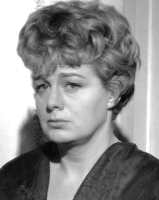 commanding the bulk of the critical attention, but it’s Shelley Winters, in a career-best performance, that I keep coming back to. Winters’ Charlotte Haze, who has the bad luck of being the dumpy custodian to every middle-age man’s fantasy nymphette, is not, to put it mildly, the brightest bulb on the Christmas Tree. She’s a mass of silly pretensions and hormonal urges, driven in equal measure by a desire to attain of measure of sophistication and a panicky, menopausal sexual hunger. Of course, her ideas about what qualifies as sophisticated are mostly wrong, and her romantic ideals and sexual energies are woefully misplaced if not completely inappropriate. She's an clod who fancies herself the heroine in a play by Noel Coward; everything about her is based in folly, and it would be easy to write her off as a walking punchline — that is, if the actress didn’t give us such harrowing glimpses of the loneliness and desperation that have shaped her character’s ridiculousness. Of course, Winters is howlingly funny playing up her character’s vulgarity and idiocy, but what ultimately emerges is a genuinely tragic figure — one who is made all too achingly aware of her own pathetic limitations. Credit the talent and skill of Shelley Winters that Charlotte Haze is a joke that, in the end, is just too painful to laugh at.
commanding the bulk of the critical attention, but it’s Shelley Winters, in a career-best performance, that I keep coming back to. Winters’ Charlotte Haze, who has the bad luck of being the dumpy custodian to every middle-age man’s fantasy nymphette, is not, to put it mildly, the brightest bulb on the Christmas Tree. She’s a mass of silly pretensions and hormonal urges, driven in equal measure by a desire to attain of measure of sophistication and a panicky, menopausal sexual hunger. Of course, her ideas about what qualifies as sophisticated are mostly wrong, and her romantic ideals and sexual energies are woefully misplaced if not completely inappropriate. She's an clod who fancies herself the heroine in a play by Noel Coward; everything about her is based in folly, and it would be easy to write her off as a walking punchline — that is, if the actress didn’t give us such harrowing glimpses of the loneliness and desperation that have shaped her character’s ridiculousness. Of course, Winters is howlingly funny playing up her character’s vulgarity and idiocy, but what ultimately emerges is a genuinely tragic figure — one who is made all too achingly aware of her own pathetic limitations. Credit the talent and skill of Shelley Winters that Charlotte Haze is a joke that, in the end, is just too painful to laugh at.In 1940, Ginger Rogers dyed her trademark platinum tresses a dull shade of brown and got her Oscar — for serious hair and serious acting. Her earnest, unimaginative work in Kitty Foyle didn’t betray so much as an ounce of the spark and savvy that informed the performances for which she is cherished. There’s a charge and intelligence to Rogers’ work in Stage Door that the actress would never again equal in her career. Perhaps working alongside Katharine Hepburn brought out the best in her. They were the two biggest female stars at RKO in the 1930s — it was a notoriously unfriendly rivalry. Kate, along with everyone else, believed herself to be the better actress of the two,
 and made it known in subtle ways that she didn’t really consider Ginger an equal — or a threat. Ginger was self-conscious, insulted, and ultimately, not one to back down from a fight. When the two trade barbs in their scenes together, what you’re hearing is an authentic battling rhythm fueled by genuine animosity and a spirit of competition. Maybe it took a slap in the face and a challenge to bring out both the toughness and the vulnerability in Ginger Rogers — whether that’s true or not, watching Stage Door, you’re glad it’s there, because the actress is unmistakably at the top of her form. As wisecracking chorine Jean Maitland, Rogers has a devastating way with a quip — her delivery of the film’s zingy one-liners is so quick, sharp and assured that it sounds like inspired improvisation. She’s a tough cookie, sure, but not immune to experiencing disappointment, or worse still, losing hope. The aspiring actresses at The Footlights Club live a precarious, uncertain existence — Rogers, more than any of the other performers, allows us to understand that comic banter is a necessary distraction from the fact that, at any moment, the girls might have their dreams and livelihoods taken away from them and fall off the grid. It’s not that Rogers simply lets us see the fear and fragility behind the snazzy retorts of these tart-tongued dames; she shows just how inextricably linked those seemingly self-contradictory properties are. She’s a smart-aleck blonde with a chip on her shoulder — as with any stand-up comedian, it’s the chip that’s the source of her comedy, even if the reality behind it is a source of hurt.
and made it known in subtle ways that she didn’t really consider Ginger an equal — or a threat. Ginger was self-conscious, insulted, and ultimately, not one to back down from a fight. When the two trade barbs in their scenes together, what you’re hearing is an authentic battling rhythm fueled by genuine animosity and a spirit of competition. Maybe it took a slap in the face and a challenge to bring out both the toughness and the vulnerability in Ginger Rogers — whether that’s true or not, watching Stage Door, you’re glad it’s there, because the actress is unmistakably at the top of her form. As wisecracking chorine Jean Maitland, Rogers has a devastating way with a quip — her delivery of the film’s zingy one-liners is so quick, sharp and assured that it sounds like inspired improvisation. She’s a tough cookie, sure, but not immune to experiencing disappointment, or worse still, losing hope. The aspiring actresses at The Footlights Club live a precarious, uncertain existence — Rogers, more than any of the other performers, allows us to understand that comic banter is a necessary distraction from the fact that, at any moment, the girls might have their dreams and livelihoods taken away from them and fall off the grid. It’s not that Rogers simply lets us see the fear and fragility behind the snazzy retorts of these tart-tongued dames; she shows just how inextricably linked those seemingly self-contradictory properties are. She’s a smart-aleck blonde with a chip on her shoulder — as with any stand-up comedian, it’s the chip that’s the source of her comedy, even if the reality behind it is a source of hurt.Sex on the silver screen has taken many different forms since the cinematic medium came into being. It can be smart and subtle, or bold and in-your-face. Sometimes it can be a tad lurid (or more than a tad) and erotically charged, other times it can be light, sophisticated fun. It can take the form of a smoldering slow-burn, creeping up on you gradually, or it can hit you right smack between the eyes like a
 guided missile. At its very best, when it’s done correctly, it can encompass all of those things, and that’s where Lauren Bacall comes in. In To Have and Have Not, she is pure sex, and it’s no wonder the characters go through so many cigarettes even when they’re just making chit-chat. Foreplay never felt so good. The film marked Bacall’s film debut — not that you’d know it from watching her. Her performance is so smooth and knowing that it feels like the work of a seasoned professional. She was (by her own admission) still a virgin when she made it, and you wouldn’t know that either. Her performance is so smooth and knowing that it feels like the work of…never mind. Her character’s name is Slim, a shady lady stranded in exotic, dangerous Martinique (sort of an island stand-in for Casablanca), and when she strikes up a flirtation with Humphrey Bogart, the sparks all but burn holes in the celluloid. Her husky-voiced sultriness is utterly intoxicating, and when, in the film’s most oft-quoted sequence, she instructs Bogie’s Steve how to whistle, it’s a moment of pure magic. Even if you’ve seen the clip or heard the words before, in context, it still sends shivers down your spine. Had anyone before attempted such a forthright sexuality on the screen? Would anyone do so as successfully again? Bacall created the template for all sirens to follow, and very few (if any) have ever really measured up to it.
guided missile. At its very best, when it’s done correctly, it can encompass all of those things, and that’s where Lauren Bacall comes in. In To Have and Have Not, she is pure sex, and it’s no wonder the characters go through so many cigarettes even when they’re just making chit-chat. Foreplay never felt so good. The film marked Bacall’s film debut — not that you’d know it from watching her. Her performance is so smooth and knowing that it feels like the work of a seasoned professional. She was (by her own admission) still a virgin when she made it, and you wouldn’t know that either. Her performance is so smooth and knowing that it feels like the work of…never mind. Her character’s name is Slim, a shady lady stranded in exotic, dangerous Martinique (sort of an island stand-in for Casablanca), and when she strikes up a flirtation with Humphrey Bogart, the sparks all but burn holes in the celluloid. Her husky-voiced sultriness is utterly intoxicating, and when, in the film’s most oft-quoted sequence, she instructs Bogie’s Steve how to whistle, it’s a moment of pure magic. Even if you’ve seen the clip or heard the words before, in context, it still sends shivers down your spine. Had anyone before attempted such a forthright sexuality on the screen? Would anyone do so as successfully again? Bacall created the template for all sirens to follow, and very few (if any) have ever really measured up to it.1927 marked the inaugural year of the Academy Awards. The acting nominations were largely forgettable. It would have been a golden opportunity for the Academy to recognize one of the screen’s great comic geniuses giving, quite possibly, his very best performance. At the time of its release, however, The General was not regarded as a masterpiece, or really, as much of anything at all beyond a slight and amusing comedy that hadn’t made money. Just as Keaton’s lovelorn hero, Johnnie Gray, must suffer the indignities of rejection by
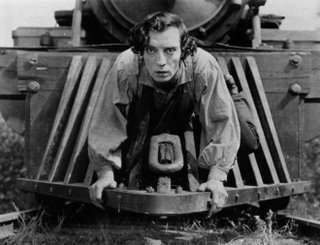 the draft board and the subsequent disdain of his prospective bride, the film’s true worth would not be recognized until it had proved itself over the course of time. Keaton’s acrobatic style, his daredevil attitude toward stuntwork and athletic enactment of the slapstick element, marked him as perhaps the most versatile physical comedian in the history of the medium. The Keaton persona functioned, on some level, as a contradiction in terms, and to glorious effect; the juxtapostion of the vibrant, hyper-animated physical comedy with a face that rarely changed expression (deadpan, dour stoicism) heightened the audience’s enjoyment of the routine. Keaton understood the value of contrast; while his body was forever in motion, contorting itself in sublime and ridiculous ways, the earnest expression always remained intact. In The General, his clowning is inspired, to be sure, but he also provides the audience with a character worth rooting for. Endearingly mawkish in his sweetheart’s presence, he must summon his inner hero when she is placed at risk. Johnnie Gray has a wistful obliviousness to everything going on around him, which only serves to enhance the comedy — his pursuit of his kidnapped ladylove is so single-minded, and his focus on his objective so intense, that he barely has time to register the dangers in his midst. It’s a deft, dextrous performance that impresses with more than just the technical skill that went into it; Keaton imbues his character with an indomitable spirit and a plucky refusal to accept defeat that put the audience firmly in his corner.
the draft board and the subsequent disdain of his prospective bride, the film’s true worth would not be recognized until it had proved itself over the course of time. Keaton’s acrobatic style, his daredevil attitude toward stuntwork and athletic enactment of the slapstick element, marked him as perhaps the most versatile physical comedian in the history of the medium. The Keaton persona functioned, on some level, as a contradiction in terms, and to glorious effect; the juxtapostion of the vibrant, hyper-animated physical comedy with a face that rarely changed expression (deadpan, dour stoicism) heightened the audience’s enjoyment of the routine. Keaton understood the value of contrast; while his body was forever in motion, contorting itself in sublime and ridiculous ways, the earnest expression always remained intact. In The General, his clowning is inspired, to be sure, but he also provides the audience with a character worth rooting for. Endearingly mawkish in his sweetheart’s presence, he must summon his inner hero when she is placed at risk. Johnnie Gray has a wistful obliviousness to everything going on around him, which only serves to enhance the comedy — his pursuit of his kidnapped ladylove is so single-minded, and his focus on his objective so intense, that he barely has time to register the dangers in his midst. It’s a deft, dextrous performance that impresses with more than just the technical skill that went into it; Keaton imbues his character with an indomitable spirit and a plucky refusal to accept defeat that put the audience firmly in his corner.Robert Walker was a very ordinary looking man with a very ordinary looking career. He spent the 1940s trading on his bland handsomeness by playing blandly wholesome boy-next-door types. He played them blandly. For anyone bored or disbelieving enough to challenge this assertion, his most notable films of the period are Since You Went Away and The Clock. The Age of Bloodless Blandness ended abruptly in
 the mid-'40s when the actor’s life took a precipitous tailspin into hell. His wife, Jennifer Jones, left him for producer David O. Selznick, taking their two young sons with her. His career went nowhere. He started drinking, became paranoid and prone to suicidal depression. Alcoholism and the mental strain of believing the world was against him gradually eroded his boyish good looks. He had a breakdown, and was institutionalized briefly. Then he met Alfred Hitchcock. The rest of the industry had written him off as a bland nicety onscreen and a walking trainwreck off — but Hitch knew exactly what he was looking at, and exactly how to exploit it. For the record, Walker died within a year of having completed Strangers on a Train — it’s tempting to think that by surrendering so completely to the sad wreckage of his life and madness in order to give the performance of a lifetime, he quite simply had nothing left. In the film, Walker plays Bruno, the mercurial, demented and diabolical architect of another man’s near-undoing. Disturbed and disturbing, there’s an eerie calm to the character as Walker plays him; it’s as if he can’t help but smile, ruefully and with a certain degree of fatalistic pleasure, at the sad joke that his life has become and the misery that his mere existence can inflict on others. It’s difficult to know how much of Walker’s performance qualifies as acting and how much of it is the genuine spectacle of tortured soul giving way to his inner demons, drowning before our very eyes. Either way, it’s mesmerizing.
the mid-'40s when the actor’s life took a precipitous tailspin into hell. His wife, Jennifer Jones, left him for producer David O. Selznick, taking their two young sons with her. His career went nowhere. He started drinking, became paranoid and prone to suicidal depression. Alcoholism and the mental strain of believing the world was against him gradually eroded his boyish good looks. He had a breakdown, and was institutionalized briefly. Then he met Alfred Hitchcock. The rest of the industry had written him off as a bland nicety onscreen and a walking trainwreck off — but Hitch knew exactly what he was looking at, and exactly how to exploit it. For the record, Walker died within a year of having completed Strangers on a Train — it’s tempting to think that by surrendering so completely to the sad wreckage of his life and madness in order to give the performance of a lifetime, he quite simply had nothing left. In the film, Walker plays Bruno, the mercurial, demented and diabolical architect of another man’s near-undoing. Disturbed and disturbing, there’s an eerie calm to the character as Walker plays him; it’s as if he can’t help but smile, ruefully and with a certain degree of fatalistic pleasure, at the sad joke that his life has become and the misery that his mere existence can inflict on others. It’s difficult to know how much of Walker’s performance qualifies as acting and how much of it is the genuine spectacle of tortured soul giving way to his inner demons, drowning before our very eyes. Either way, it’s mesmerizing.Robert Mitchum had the easy, insolent manner of a guy who knew he’d never be taken seriously by the snobs and didn’t really give a shit. He was a maverick, and by Hollywood standards, a bit of a punk. The media pegged him for a dumb lug, an inarticulate slab of beefcake with biceps for brains and a bad boy attitude — it was an image that stuck for years, in spite of the fact that it bore very little relation to
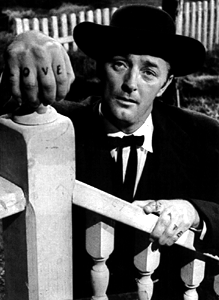 the man himself; those who worked with him invariably described him as both highly intelligent and a consummate professional. He received but one nomination — as best supporting actor for an early role in The Story of G.I. Joe — while his four-plus decades of work as a star were completely ignored. As if to shame the establishment’s self-righteous sense of the natural order, the lunkhead produced a body of work which made the careers of his Oscar-winning contemporaries (such as David Niven, Hollywood’s Mr. Class President, for example) look shallow and irrelevant by comparison. From a bumper crop of egregiously overlooked performances, I submit The Night of the Hunter as his very best. As the wayward preacher whose gleaming smile disguises a black heart, the actor creates a study in villainy that manages to be both charming and chilling at the same time. Traditional movie sociopaths (and there are several on this list) are withdrawn and enclosed, wound as tightly as watches and wrapped up in their own inner torment. Mitchum’s Harry Powell has a big, expansive personality, with the engaging manner, sweeping cadence and seductive charm of a born evangelist. A not-so-distant cousin to Burt Lancaster’s Elmer Gantry, he’s equal parts false prophet and barnstorming huckster — butter wouldn’t melt in his mouth, and when he’s working his wiles on the gullible country boobs who comprise his congregation, they’re spoonfed easy-to-swallow morsels of fire and brimstone drenched in buttermilk gravy. He’s a counterfeit quarter that shines as brightly as a new silver dollar, and it’s only when you note the cold, dead look in his eyes that you can begin to hear the hollow ring of his sermons. It’s an astute, measured performance; the character is brazen, alright, but Mitchum resists the urge to turn him into a caricature. A cunning and deliberate predator as opposed to a wild-eyed maniac, Mitchum doesn’t run after his prey; whistling a tune, he strolls.
the man himself; those who worked with him invariably described him as both highly intelligent and a consummate professional. He received but one nomination — as best supporting actor for an early role in The Story of G.I. Joe — while his four-plus decades of work as a star were completely ignored. As if to shame the establishment’s self-righteous sense of the natural order, the lunkhead produced a body of work which made the careers of his Oscar-winning contemporaries (such as David Niven, Hollywood’s Mr. Class President, for example) look shallow and irrelevant by comparison. From a bumper crop of egregiously overlooked performances, I submit The Night of the Hunter as his very best. As the wayward preacher whose gleaming smile disguises a black heart, the actor creates a study in villainy that manages to be both charming and chilling at the same time. Traditional movie sociopaths (and there are several on this list) are withdrawn and enclosed, wound as tightly as watches and wrapped up in their own inner torment. Mitchum’s Harry Powell has a big, expansive personality, with the engaging manner, sweeping cadence and seductive charm of a born evangelist. A not-so-distant cousin to Burt Lancaster’s Elmer Gantry, he’s equal parts false prophet and barnstorming huckster — butter wouldn’t melt in his mouth, and when he’s working his wiles on the gullible country boobs who comprise his congregation, they’re spoonfed easy-to-swallow morsels of fire and brimstone drenched in buttermilk gravy. He’s a counterfeit quarter that shines as brightly as a new silver dollar, and it’s only when you note the cold, dead look in his eyes that you can begin to hear the hollow ring of his sermons. It’s an astute, measured performance; the character is brazen, alright, but Mitchum resists the urge to turn him into a caricature. A cunning and deliberate predator as opposed to a wild-eyed maniac, Mitchum doesn’t run after his prey; whistling a tune, he strolls.Beloved by the public, Charlie Chaplin was never fully embraced by Hollywood. Nor was he particularly trusted. His work, which always contained subtle social commentary even when it was at its most side-splittingly comic, was suspected of being subversive — even when those made most uneasy by it couldn’t fully grasp what made it so. Perhaps Hollywood wasn’t quite ready for comedy with a heart, or
 worse still, a mind. He was nominated twice for best actor — first for The Circus, and again for The Great Dictator, which was deemed acceptable since it was in keeping with the political sympathies of the establishment (Hitler was the villain, as supposed to modern industry or class hypocrisy). His two undisputed masterpieces, City Lights and Modern Times, were left out in the cold. As a film, I slightly prefer the latter, but Chaplin probably gave his best and most heartfelt performance in City Lights. As one might expect, Chaplin’s talent for physical comedy is on full display in City Lights, in several ingeniously conceived and executed sequences (the boxing match is one of the funniest ever filmed). But what really makes the performance shine is its humanity — more so than in any other film he made, Chaplin’s Little Tramp exists as beacon of hope and kindness in a cold and unfeeling world. He’s a resilient everyman whose fundamental decency keeps him afloat in the face of seemingly insurmountable odds. It would have been easy to cast himself as a victim — he’s bullied, batted around and generally humiliated by the callous “respectable” people he’s encounters, including the police, but he always retains his dignity and his belief in the existence of good in the world. That’s the reason people cry at the ending of the film — the sensitivity and compassion of Chaplin’s performance convince us that life, in spite of its cruelties, can truly be beautiful.
worse still, a mind. He was nominated twice for best actor — first for The Circus, and again for The Great Dictator, which was deemed acceptable since it was in keeping with the political sympathies of the establishment (Hitler was the villain, as supposed to modern industry or class hypocrisy). His two undisputed masterpieces, City Lights and Modern Times, were left out in the cold. As a film, I slightly prefer the latter, but Chaplin probably gave his best and most heartfelt performance in City Lights. As one might expect, Chaplin’s talent for physical comedy is on full display in City Lights, in several ingeniously conceived and executed sequences (the boxing match is one of the funniest ever filmed). But what really makes the performance shine is its humanity — more so than in any other film he made, Chaplin’s Little Tramp exists as beacon of hope and kindness in a cold and unfeeling world. He’s a resilient everyman whose fundamental decency keeps him afloat in the face of seemingly insurmountable odds. It would have been easy to cast himself as a victim — he’s bullied, batted around and generally humiliated by the callous “respectable” people he’s encounters, including the police, but he always retains his dignity and his belief in the existence of good in the world. That’s the reason people cry at the ending of the film — the sensitivity and compassion of Chaplin’s performance convince us that life, in spite of its cruelties, can truly be beautiful.There are certain things in life I will never be able to explain or understand. I could not, for instance, explain the process by which a tennis match being played in Brazil can be viewed, live and as clear as daylight, in my living room here in Albany, NY — I take it for granted that it’s possible, but for the life of me, I have no idea how it happens. Similarly, I can’t even begin to fathom how Edward G. Robinson, in a career spanning more than 40 years, was not once ever nominated for an Academy Award. Was it the fact that no movie star has ever looked less like a movie star? Was he too old by the time he broke through, too much of a character actor as opposed to a traditional
 leading man? Too much of a class act to play the campaigning game? Too Jewish? I have no idea. In any case, it’s a travesty which the Academy, bless them, attempted to correct with an honorary award toward the end of his life. I suppose it’s the thought that counts. In Billy Wilder’s classic tale of lust, murder and betrayal — generally regarded as the definitive film noir — Robinson plays Keyes, the chief claims investigator for an insurance company, who knows in his gut that “grieving widow” Barbara Stanwyck is a tarantula in sheep’s clothing. Dogged, determined, and shrewd to the point of having supernatural ability, Keyes is a bloodhound hot on the scent. He exists in the great tradition of classic sleuths such as Hercule Poirot — a keen student of human behavior with unimpeachable instincts, he doesn’t allow so much as the smallest detail to escape his bug-eyed vigilance. Such pillars of indefatigability can be one-note and wearying, often inspiring more admiration than affection, but Robinson makes Keyes such an endearingly idiosyncratic presence that you only sit back and marvel at his scowling certitude and inexhaustible vitality. Synapses clicking at warp speed, he paces back and forth while irritably chomping on his cigar in restless anticipation of a moment of clarity. When it inevitably comes, his face lights up like a kid on Christmas morning. You can understand how Fred MacMurray’s anxious murderer can’t help rooting for Keyes to figure it out, even though it means his own neck. As much fun as he is, Robinson’s performance ends on a note of almost unbearable grace and humanity. Having finally collared his criminal, all his hunches having born out, there is no room for celebration or smug self-satisfaction. Instead, Robinson shows us only disappointment, pity, and on some level, a rueful kind of empathy. Sometimes, there’s no pleasure to be had in having been right.
leading man? Too much of a class act to play the campaigning game? Too Jewish? I have no idea. In any case, it’s a travesty which the Academy, bless them, attempted to correct with an honorary award toward the end of his life. I suppose it’s the thought that counts. In Billy Wilder’s classic tale of lust, murder and betrayal — generally regarded as the definitive film noir — Robinson plays Keyes, the chief claims investigator for an insurance company, who knows in his gut that “grieving widow” Barbara Stanwyck is a tarantula in sheep’s clothing. Dogged, determined, and shrewd to the point of having supernatural ability, Keyes is a bloodhound hot on the scent. He exists in the great tradition of classic sleuths such as Hercule Poirot — a keen student of human behavior with unimpeachable instincts, he doesn’t allow so much as the smallest detail to escape his bug-eyed vigilance. Such pillars of indefatigability can be one-note and wearying, often inspiring more admiration than affection, but Robinson makes Keyes such an endearingly idiosyncratic presence that you only sit back and marvel at his scowling certitude and inexhaustible vitality. Synapses clicking at warp speed, he paces back and forth while irritably chomping on his cigar in restless anticipation of a moment of clarity. When it inevitably comes, his face lights up like a kid on Christmas morning. You can understand how Fred MacMurray’s anxious murderer can’t help rooting for Keyes to figure it out, even though it means his own neck. As much fun as he is, Robinson’s performance ends on a note of almost unbearable grace and humanity. Having finally collared his criminal, all his hunches having born out, there is no room for celebration or smug self-satisfaction. Instead, Robinson shows us only disappointment, pity, and on some level, a rueful kind of empathy. Sometimes, there’s no pleasure to be had in having been right.For the first decade of her career, Ingrid Bergman’s halo never touched the ground. She was nominated for best actress four times in the 1940s, twice for playing angelic victims of male cruelty, and twice for playing saints. Even her Ilsa in Casablanca was wholesome girl at heart whom no one would think twice about bringing home to mother. Her style was so open and natural that, as beautiful as she was, it was impossible to conceive of anything base or impure in her; in every role, she positively glowed. Thankfully, Alfred Hitchcock was either canny or perverse enough to see things in popular performers that other people hardly even dared to imagine. Cary Grant was the personification of breezy affability onscreen — his wives (there were five or so) described him as guarded and remote. Hitch was the only filmmaker ever to catch a whiff of the coldness in Grant, and in Suspicion (and even more explicitly in this film), he brought it to the forefront. Similarly, he was the only one who ever picked up on Ingrid Bergman’s inner wantonness — by the end of the '40s, the actress
 would be embroiled in a tabloid sex scandal involving Italian director Roberto Rossellini, denounced on the floor of the U.S. Congress as a scarlet woman, and find herself blackballed by Hollywood for seven years. It was the kind of mess you’d expect Alicia Huberman, the character she played so memorably in Notorious, to find herself mixed up in. Unfortunately, in 1946, the Academy simply wasn’t ready to accept a more complicated version of their reigning virgin goddess. When we first encounter Bergman’s character, it comes as something of a shock. Instead of the serene enchantress we’ve come to expect, we see a dissolute, damaged woman consumed by self-loathing and working with reckless abandon towards her own self-destruction. She holds herself in even lower regard than the men whom she allows herself to be casually used by. In a cruel twist of fate, once she finally gains a measure of self-respect and a reason to reform, she must literally prostitute herself for her country’s benefit. Bergman shows us the hurt and shame her character feels when Grant refuses to acknowledge the ways in which she’s changed; his withering contempt only stiffens her resolve to prove her worth — to him and to herself. As a government spy married off to a Nazi criminal, her entire life has become a lie, but she’s never had more of a sense of purpose. In the second half of the film, Bergman registers the growing dread of someone who realizes she’s been employed as a sacrificial lamb and is walking a tightrope through a minefield; the slightest misstep could spell catastrophe, but she keeps her nerve. It’s a fearless, gutsy performance, not least because of the uninhibited sexuality Bergman gets to express — the famous single-take kissing scene, where Grant and Bergman make out for no less than four minutes while the camera orbits around them in swoony delight, is such a decadent feat of showmanship that it’s a wonder they got away with it. Bergman is no less radiant here than in her other performances, but Notorious was the only film brave enough to give her a sexual appetite.
would be embroiled in a tabloid sex scandal involving Italian director Roberto Rossellini, denounced on the floor of the U.S. Congress as a scarlet woman, and find herself blackballed by Hollywood for seven years. It was the kind of mess you’d expect Alicia Huberman, the character she played so memorably in Notorious, to find herself mixed up in. Unfortunately, in 1946, the Academy simply wasn’t ready to accept a more complicated version of their reigning virgin goddess. When we first encounter Bergman’s character, it comes as something of a shock. Instead of the serene enchantress we’ve come to expect, we see a dissolute, damaged woman consumed by self-loathing and working with reckless abandon towards her own self-destruction. She holds herself in even lower regard than the men whom she allows herself to be casually used by. In a cruel twist of fate, once she finally gains a measure of self-respect and a reason to reform, she must literally prostitute herself for her country’s benefit. Bergman shows us the hurt and shame her character feels when Grant refuses to acknowledge the ways in which she’s changed; his withering contempt only stiffens her resolve to prove her worth — to him and to herself. As a government spy married off to a Nazi criminal, her entire life has become a lie, but she’s never had more of a sense of purpose. In the second half of the film, Bergman registers the growing dread of someone who realizes she’s been employed as a sacrificial lamb and is walking a tightrope through a minefield; the slightest misstep could spell catastrophe, but she keeps her nerve. It’s a fearless, gutsy performance, not least because of the uninhibited sexuality Bergman gets to express — the famous single-take kissing scene, where Grant and Bergman make out for no less than four minutes while the camera orbits around them in swoony delight, is such a decadent feat of showmanship that it’s a wonder they got away with it. Bergman is no less radiant here than in her other performances, but Notorious was the only film brave enough to give her a sexual appetite.There are other sociopaths on this list — Walker, Mitchum, and Cagney — but there was, and is, only one Psycho. For anyone who hasn’t seen it, proceed with caution — this entry includes some spoilers. As a young actor in Hollywood, Anthony Perkins never really fit in anywhere. Too skinny and self-consciously awkward to be a heartthrob, too delicately handsome to qualify as a character actor, in the 1950s he drifted with a reasonable degree of success through a series of juvenile roles, typically cast as a misunderstood adolescent. The fact that he never fully seemed comfortable in his own skin was only partially an act — Perkins was, up until the time of his death of AIDS in 1992, a closeted homosexual who was never able to shake the conviction that something was deeply wrong with him. From the late
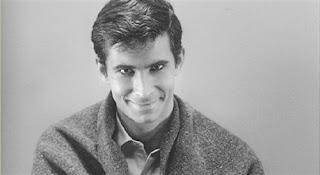 1950s until his marriage in the 1970s, he received treatment from a controversial psychotherapist whose field of specialty was curing the “affliction” from which he suffered. Riddled with anguish and guilt, he never came to terms with who he was, nor managed to break free of the sense of stigma that was, to some degree, self-imposed. One of the themes to emerge from this assignment has been the canny ability of Alfred Hitchcock for pairing actors with roles that gave telling expression to their hidden selves. As Norman Bates, Perkins gives a painful account of an unformed personality, stunted in his growth by a cruel and overbearing mother who exerts her tyranny over him even from beyond the grave. A prisoner of his own isolation and sense of inadequacy, his attempts to reach out to another human being, Janet Leigh’s Marion Crane, are touching in their pathetic, halting ineptitude. For allowing himself to feel, whether it’s sexual attraction or simply a bond of kindred spirits, he must be punished, and the dispensing of bloody justice falls to his demonic alter ego. He simply isn’t equipped to handle the feelings that interaction with the kind, accepting Marion produces; in the end, both fall victim to Norman’s sense of shame. The way that Perkins registers the guilt and horror of what “Mother” has done is the crux of the film’s tragedy; the object of the murder is never to destroy Marion, but rather to suppress and ultimately extinguish the feelings that Norman has no means of coping with. It isn’t the celebrated shower scene that makes Psycho one of the most frightening films ever made; it’s the realization that Norman Bates isn’t a monster.
1950s until his marriage in the 1970s, he received treatment from a controversial psychotherapist whose field of specialty was curing the “affliction” from which he suffered. Riddled with anguish and guilt, he never came to terms with who he was, nor managed to break free of the sense of stigma that was, to some degree, self-imposed. One of the themes to emerge from this assignment has been the canny ability of Alfred Hitchcock for pairing actors with roles that gave telling expression to their hidden selves. As Norman Bates, Perkins gives a painful account of an unformed personality, stunted in his growth by a cruel and overbearing mother who exerts her tyranny over him even from beyond the grave. A prisoner of his own isolation and sense of inadequacy, his attempts to reach out to another human being, Janet Leigh’s Marion Crane, are touching in their pathetic, halting ineptitude. For allowing himself to feel, whether it’s sexual attraction or simply a bond of kindred spirits, he must be punished, and the dispensing of bloody justice falls to his demonic alter ego. He simply isn’t equipped to handle the feelings that interaction with the kind, accepting Marion produces; in the end, both fall victim to Norman’s sense of shame. The way that Perkins registers the guilt and horror of what “Mother” has done is the crux of the film’s tragedy; the object of the murder is never to destroy Marion, but rather to suppress and ultimately extinguish the feelings that Norman has no means of coping with. It isn’t the celebrated shower scene that makes Psycho one of the most frightening films ever made; it’s the realization that Norman Bates isn’t a monster.One of the most shocking realizations of my adult life is that “Over the Rainbow” is not, in fact, a great song. The melody is simplistic and the lyrics are sappy to the point of revulsion — that is, unless you can keep a straight face when hearing about troubles melting like lemon drops and happy little bluebirds flying over pretty rainbows. Otherwise, one must concede that it’s the kind of sugary junk that would give even the cuddliest of Care Bears a toothache. This painful realization came only after I’d heard someone other than Judy Garland try to sing it — a few other people actually, and mostly very accomplished performers. The folly lay in the attempt, for Garland’s rendition has never, and will never, be matched. It is, without question, the greatest single piece of music ever created for the screen and the most hauntingly poetic, if not for any of its own qualities, then quite simply because she sang it. Make no mistake — there’s a lot more to the performance than “Over the Rainbow.” No role, with the possible exception of A Star is Born, made more demands of Garland as an actress, and not even the 1954 film brought her vulnerability as strongly into focus. As with the majority of the performances on this list, there’s a story behind the story — and perhaps no other characterization was informed as strongly by an actor’s reality. Although she is most closely associated with the timeless children’s tale by L. Frank Baum, Garland’s own childhood bore a closer resemblance to something out of The Brothers Grimm. At the age of 13, Frances Gumm was sold to MGM by an apathetic father and
 opportunistic mother, neither of whom saw any need to question the studio’s peculiar practices regarding the management and maintenance of juvenile talent. In the dark, quasi-Dickensian era before the passage of child labor laws, the rechristened Judy Garland became a full-time working professional, was prevented from pursuing much of a social life beyond the iron gates of the studio, given pills to help manage her weight, and still more pills to see her through the grueling 14 hour work days. The scars of these early years, which the actress would ruefully recall as among the most difficult in her life, would never fully heal. Life only became more complicated with the transition to adulthood. As a film, The Wizard of Oz may be about as far away from realism one can get; yet somehow, in the midst of all the Technicolor sorcery, Judy Garland creates a character based in recognizable truth. It’s a deceptively simple, natural performance; in a way, Judy Garland and Dorothy Gale are one in the same, trying to make sense of the world around them and their own unspoken fears and insecurities. There’s a scene that stands out for me – when she’s trapped in the witch’s tower, terrified and alone, she cries out for Auntie Em (“Auntie Em, I’m frightened…”). The emotion that fuels the scene is visceral and genuine — doubtless Garland could relate to the desperate need for some kind of stable, nurturing influence, not only to shield and protect, but dispel the darkness that exists just beneath the surface of the wonderful world of make-believe and fantasy (Oz could just as easily be Hollywood). When she sings “Over the Rainbow,” leaning against a haystack and gazing wistfully up to the skies, it’s the ultimate expression of the inchoate yearnings of adolescence, the need for acceptance and deliverance from isolation and loneliness. The song promises escape to a world where contentment and freedom from worry are attainable properties. Listen closely to Judy Garland when she sings the words — she means them. The simplicity and the conviction with which the character’s inner life is made explicit in this moment is a marvel to behold — sad, beguiling and utterly haunting. Whenever the actress would perform “Over the Rainbow” in numerous late-career concert appearances, she did so with a catch in her voice and a tear in her eye — on some occasions she’d be sobbing profusely by the song’s conclusion. It’s more likely than not that there was an element of showmanship in these displays, but her delivery revealed the existence of something more — a sad recognition of the fact that, unlike the character she played, Judy Garland never quite made it to that place where troubles melt like lemon drops and dreams really do come true. Real life doesn’t often afford such opportunities.
opportunistic mother, neither of whom saw any need to question the studio’s peculiar practices regarding the management and maintenance of juvenile talent. In the dark, quasi-Dickensian era before the passage of child labor laws, the rechristened Judy Garland became a full-time working professional, was prevented from pursuing much of a social life beyond the iron gates of the studio, given pills to help manage her weight, and still more pills to see her through the grueling 14 hour work days. The scars of these early years, which the actress would ruefully recall as among the most difficult in her life, would never fully heal. Life only became more complicated with the transition to adulthood. As a film, The Wizard of Oz may be about as far away from realism one can get; yet somehow, in the midst of all the Technicolor sorcery, Judy Garland creates a character based in recognizable truth. It’s a deceptively simple, natural performance; in a way, Judy Garland and Dorothy Gale are one in the same, trying to make sense of the world around them and their own unspoken fears and insecurities. There’s a scene that stands out for me – when she’s trapped in the witch’s tower, terrified and alone, she cries out for Auntie Em (“Auntie Em, I’m frightened…”). The emotion that fuels the scene is visceral and genuine — doubtless Garland could relate to the desperate need for some kind of stable, nurturing influence, not only to shield and protect, but dispel the darkness that exists just beneath the surface of the wonderful world of make-believe and fantasy (Oz could just as easily be Hollywood). When she sings “Over the Rainbow,” leaning against a haystack and gazing wistfully up to the skies, it’s the ultimate expression of the inchoate yearnings of adolescence, the need for acceptance and deliverance from isolation and loneliness. The song promises escape to a world where contentment and freedom from worry are attainable properties. Listen closely to Judy Garland when she sings the words — she means them. The simplicity and the conviction with which the character’s inner life is made explicit in this moment is a marvel to behold — sad, beguiling and utterly haunting. Whenever the actress would perform “Over the Rainbow” in numerous late-career concert appearances, she did so with a catch in her voice and a tear in her eye — on some occasions she’d be sobbing profusely by the song’s conclusion. It’s more likely than not that there was an element of showmanship in these displays, but her delivery revealed the existence of something more — a sad recognition of the fact that, unlike the character she played, Judy Garland never quite made it to that place where troubles melt like lemon drops and dreams really do come true. Real life doesn’t often afford such opportunities.Rosalind Russell was a tall, almost ungainly woman with a raspy contralto voice and plain, sensible features. Her non-nonsense appearance, which was smart and well-tailored without being austere, suggested both a practical outlook and a bemused sense of irony. No one would ever mistake her for an ingénue or a sex goddess, which probably suited her just fine. Never beautiful in the conventional sense, she could generate more heat with an arched eyebrow and a deadpan retort than any of the glamour girls could with smoldering looks and coy
 displays of their natural assets. She could be delightfully over-the-top in films that tapped into the zanier side of her nature — Auntie Mame is probably still the role with which she is most identified — but it’s His Girl Friday that really showcases the full and glorious spectrum of her talent. The role of Hildy Johnson was originally written for a man, and in its transmogrified incarnation could have easily come across as a shrill, insulting parody of the tough-minded career woman as a masculine (or worse still, asexual) entity. But Rosalind Russell was much too smart, and far too inventive, to fall into that trap — her Hildy is one of the boys, alright, but she’s more woman than ever. For the first time in motion pictures, here was a truly modern woman — not only the professional equal of her male counterparts, but with a quickness and creativity that leaves them in the dust. Russell’s Hildy is an ace reporter who can outtalk, outthink and out-maneuver every man in the room, and rather than resent her for it, they can only peer out from under their porkpie hats and newsman’s visors with a mixture of awe and respect as she runs circles around the rest of them. The actress is a whirling dervish of energy, and you’ll be amazed at how fast her motor runs — she sprints through entire pages of dialogue at warp speed without missing a beat, and her inflections throughout are priceless. She throws herself into the part with the same kind of edgy, go-for-broke tenacity that her character exhibits when chasing headlines, and makes it clear that, for Hildy Johnson, no other kind of life is possible. She needs the thrill of the chase, and a guy like Walter Burns who can not only keep up with her, but is only too happy to let her run with the wolves. That’s why nice, bland Ralph Bellamy has to be sent packing at the end of the picture — there’s no way he could avoid being blown away by this sonic boom in heels.
displays of their natural assets. She could be delightfully over-the-top in films that tapped into the zanier side of her nature — Auntie Mame is probably still the role with which she is most identified — but it’s His Girl Friday that really showcases the full and glorious spectrum of her talent. The role of Hildy Johnson was originally written for a man, and in its transmogrified incarnation could have easily come across as a shrill, insulting parody of the tough-minded career woman as a masculine (or worse still, asexual) entity. But Rosalind Russell was much too smart, and far too inventive, to fall into that trap — her Hildy is one of the boys, alright, but she’s more woman than ever. For the first time in motion pictures, here was a truly modern woman — not only the professional equal of her male counterparts, but with a quickness and creativity that leaves them in the dust. Russell’s Hildy is an ace reporter who can outtalk, outthink and out-maneuver every man in the room, and rather than resent her for it, they can only peer out from under their porkpie hats and newsman’s visors with a mixture of awe and respect as she runs circles around the rest of them. The actress is a whirling dervish of energy, and you’ll be amazed at how fast her motor runs — she sprints through entire pages of dialogue at warp speed without missing a beat, and her inflections throughout are priceless. She throws herself into the part with the same kind of edgy, go-for-broke tenacity that her character exhibits when chasing headlines, and makes it clear that, for Hildy Johnson, no other kind of life is possible. She needs the thrill of the chase, and a guy like Walter Burns who can not only keep up with her, but is only too happy to let her run with the wolves. That’s why nice, bland Ralph Bellamy has to be sent packing at the end of the picture — there’s no way he could avoid being blown away by this sonic boom in heels.The cartoon shenanigans of contemporary action and horror films are pretty tame fare compared to a show of genuine violence — whether expressed through deeds, behavior, or even something as simple as an attitude. Explosions and decapitations are all fine and good, and may even prompt a few happy hours of shrieking in the dark. But real violence — when it’s given a human face — can still make audiences squirm in their seats, and the sense of discomfort it produces can be much harder to shake in the days and weeks afterward. Cagney was emblematic of the movie tough guy — the pint-size bruiser from the wrong side of the tracks whose scrappy belligerence could detonate into bloody mayhem at a moment’s notice. It took a while for the Academy to get over their initial response of shock. His star-making turn in The Public Enemy was ignored, and an even more galvanizing performance in Angels with Dirty Faces was pushed to the
 side in favor of Spencer Tracy’s benign Father Flannagan in Boys Town. It was only when Cagney stopped being scary and starting playing nice — for his spry, ingratiating turn in Yankee Doodle Dandy — that the Academy relented and awarded him his Best Actor trophy. The award was deserved, certainly, but the impact of that performance pales in comparison to what would become the actor’s most frightening and indelible creation. Once again, Oscar was too busy averting his gaze, most likely out of fear, to give the devil his due. For the role of Cody Jarrett, for whom the term ‘mentally imbalanced’ would only barely scratch the surface, Cagney dug deeper than he ever had before, and revealed a naked emotionalism that was all the more startling for its proximity to his character’s psychotic impulses. Jarrett is a ticking time bomb of a human being, given to panic attacks and fainting spells (shades of Tony Soprano) and apt to unleash his volcanic anger upon anyone or anything in his path at any given moment. He’s defensive, defiant, and gleefully unhampered by anything akin to a moral compass. Unable to experience anything like joy or remorse, he is almost equally incapable of love….almost, that is, because of the pathological attachment he has toward his rotten old crone of a mother. When he hears of her death in prison, Cagney’s trademark sneer gives way to a working of grief and pain that is so raw in its intensity that it tears right through the fourth wall and grips the audience by the throat. The time bomb has finally gone off, and it keeps going off over and over again. Reduced to a wounded animal, Cagney rages blindly through his despair, moaning, howling, punching at the wind. It’s unthinkable that any other actor of the golden era would be willing to make himself so utterly pathetic and wretched in service to his concept of character — nowadays, it’s used as the kind of flashy pyrotechnical trick employed to garner nominations. With Cagney, it amounted to sheer nerve.
side in favor of Spencer Tracy’s benign Father Flannagan in Boys Town. It was only when Cagney stopped being scary and starting playing nice — for his spry, ingratiating turn in Yankee Doodle Dandy — that the Academy relented and awarded him his Best Actor trophy. The award was deserved, certainly, but the impact of that performance pales in comparison to what would become the actor’s most frightening and indelible creation. Once again, Oscar was too busy averting his gaze, most likely out of fear, to give the devil his due. For the role of Cody Jarrett, for whom the term ‘mentally imbalanced’ would only barely scratch the surface, Cagney dug deeper than he ever had before, and revealed a naked emotionalism that was all the more startling for its proximity to his character’s psychotic impulses. Jarrett is a ticking time bomb of a human being, given to panic attacks and fainting spells (shades of Tony Soprano) and apt to unleash his volcanic anger upon anyone or anything in his path at any given moment. He’s defensive, defiant, and gleefully unhampered by anything akin to a moral compass. Unable to experience anything like joy or remorse, he is almost equally incapable of love….almost, that is, because of the pathological attachment he has toward his rotten old crone of a mother. When he hears of her death in prison, Cagney’s trademark sneer gives way to a working of grief and pain that is so raw in its intensity that it tears right through the fourth wall and grips the audience by the throat. The time bomb has finally gone off, and it keeps going off over and over again. Reduced to a wounded animal, Cagney rages blindly through his despair, moaning, howling, punching at the wind. It’s unthinkable that any other actor of the golden era would be willing to make himself so utterly pathetic and wretched in service to his concept of character — nowadays, it’s used as the kind of flashy pyrotechnical trick employed to garner nominations. With Cagney, it amounted to sheer nerve.Where was the love for Humphrey Bogart? It finally revealed itself in 1951 when the criminally neglected actor received his one and only Oscar for his delightful performance in The African Queen. Taking nothing away from his acting in that film, it would have been just as nice if they’d acknowledged him when he’d really deserved it. His one prior nomination had been for Casablanca; history shows that he lost to someone named Paul Lukas, whose performance in Watch on the Rhine now registers as a complete zero — neither good nor bad enough to be memorable in any way, shape or form (it’s the kind of performance you’ll forget about even while you’re watching it). Bogart was not nominated for — among other things — The Maltese Falcon, High Sierra, To Have and Have Not,
 The Big Sleep, In a Lonely Place and most shockingly of all, The Treasure of the Sierra Madre. John Huston’s masterpiece, an unlikely fusion of film noir and western, is an intricately structured morality tale examining the corruptive influence of greed; as observed here, not only does it take away men’s souls, it erodes their sanity as well. Bogart plays Fred C. Dobbs, a down-and-out wastrel who is reduced to a state of twitching paranoia when he hits the mother lode, a mountain rich with untapped gold deposits. As the wealth accumulates, it brings with it an atmosphere of tension and mistrust. The actor creates an unflinching, harrowing study of a man unraveling before our very eyes, struggling to hold onto whatever clarity he may still possess and losing the battle in a spectacular fashion. Bogart’s monologues, when the character begins talking to himself (often referring to himself in the third person), are stunningly executed — they build in intensity as the character’s incipient hysteria bubbles to the surface and a sense of crazed panic overtakes his instincts. This was a Bogart no one had seen before — the consummate movie tough guy as the living embodiment of weakness…a loser. The physical transformation alone is striking, and not because the actor’s appearance was radically altered for the role, the change has more to do with body language. Whereas other Bogart performances are remarkable for their calm self-possession — their stillness, if you will — here the actor is a mass of tics and twitches, a walking catalog of the visible markings of human frailty. His slumped shoulders, the halting step of his walk, the slight tremor in his hands, and his darting eye movements communicate volumes about where Fred C. Dobbs has been, and the even darker depths toward which he’s bound.
The Big Sleep, In a Lonely Place and most shockingly of all, The Treasure of the Sierra Madre. John Huston’s masterpiece, an unlikely fusion of film noir and western, is an intricately structured morality tale examining the corruptive influence of greed; as observed here, not only does it take away men’s souls, it erodes their sanity as well. Bogart plays Fred C. Dobbs, a down-and-out wastrel who is reduced to a state of twitching paranoia when he hits the mother lode, a mountain rich with untapped gold deposits. As the wealth accumulates, it brings with it an atmosphere of tension and mistrust. The actor creates an unflinching, harrowing study of a man unraveling before our very eyes, struggling to hold onto whatever clarity he may still possess and losing the battle in a spectacular fashion. Bogart’s monologues, when the character begins talking to himself (often referring to himself in the third person), are stunningly executed — they build in intensity as the character’s incipient hysteria bubbles to the surface and a sense of crazed panic overtakes his instincts. This was a Bogart no one had seen before — the consummate movie tough guy as the living embodiment of weakness…a loser. The physical transformation alone is striking, and not because the actor’s appearance was radically altered for the role, the change has more to do with body language. Whereas other Bogart performances are remarkable for their calm self-possession — their stillness, if you will — here the actor is a mass of tics and twitches, a walking catalog of the visible markings of human frailty. His slumped shoulders, the halting step of his walk, the slight tremor in his hands, and his darting eye movements communicate volumes about where Fred C. Dobbs has been, and the even darker depths toward which he’s bound.In a career filled with wonderful characters and performances, Katharine Hepburn always was her own greatest creation. In the 1930s, she stood apart from the crowd; none of her contemporaries could touch her for originality, incisiveness or audacity. Very few films she made in the early stages of her career had the courage to run with her — at her worst, and sometimes even at her best, she could seem hopelessly affected and refined, too rare a bird to be credible as a mere mortal. She was occasionally a tomboy, but always with an element of idiosyncratic New England exoticism — a haughty Bryn Mawr elitism coupled with an air of high-starch Yankee breeding. She was not the obvious choice for the role of a dizzy heiress in a screwball comedy directed by Howard Hawks — that would have been Carole Lombard. Offbeat casting decisions often yield the highest dividends. Bringing Up Baby is nearly everyone’s favorite Katharine Hepburn
 film, and features arguably the best performance she ever gave. As Susan Vance, Hepburn decided to throw caution to the wind and let down her hair — there’s a spirit of giddy abandon in her performance, a willingness to act silly and be silly, that frees the actress from her own confining persona while at the same time referencing it in sly, nodding fashion. In a way, Hepburn spends much of the film poking fun at Hepburn. Susan has a refinement of manner and speech — doubtless the product of years of scrupulous training at the tawny prep schools and top-drawer society functions — but there’s a brittle frivolity to her cadence and attitudes that makes it impossible to take her too seriously (I could listen to clipped delivery of “No…to drop an olive…” all day long). Acting on whim and a freewheeling improvisatory logic that she alone can follow, she’ll say and do whatever pops into her head, with a blithe indifference to the precepts of decorum or any measure of reason. She seems to thrive on chaos - it brings out the romantic, adventurous side of her nature, and makes her impulsiveness that much more pronounced. When ever she utters her chirpy catchphrase — the ominous “Everything’s going to be alright” — the other characters hold their breath, waiting for the other show to drop. Breezing through the din like a typhoid Mary on roller skates, Hepburn is blissfully uninhibited and deliriously funny from start to finish; her teamwork with Cary Grant, as the bespectacled paleontologist who becomes the hapless object of her unwanted attentions, is one of the most exhilarating examples of great comic teamwork in all of films. There are so many moments to cherish — perhaps none more so when Hepburn dons the persona of ‘Swingin’ Door Susie,’ an East Side debutante’s hilariously off-kilter approximation of a hard-bitten gun moll. As much fun as she seems to be having, the actress never loses sight of what drives Susan’s eccentric and erratic behavior; at heart, she’s just a lovestruck, sentimental goof who just can’t keep her emotions in check long enough to act like a normal human being. Thank God.
film, and features arguably the best performance she ever gave. As Susan Vance, Hepburn decided to throw caution to the wind and let down her hair — there’s a spirit of giddy abandon in her performance, a willingness to act silly and be silly, that frees the actress from her own confining persona while at the same time referencing it in sly, nodding fashion. In a way, Hepburn spends much of the film poking fun at Hepburn. Susan has a refinement of manner and speech — doubtless the product of years of scrupulous training at the tawny prep schools and top-drawer society functions — but there’s a brittle frivolity to her cadence and attitudes that makes it impossible to take her too seriously (I could listen to clipped delivery of “No…to drop an olive…” all day long). Acting on whim and a freewheeling improvisatory logic that she alone can follow, she’ll say and do whatever pops into her head, with a blithe indifference to the precepts of decorum or any measure of reason. She seems to thrive on chaos - it brings out the romantic, adventurous side of her nature, and makes her impulsiveness that much more pronounced. When ever she utters her chirpy catchphrase — the ominous “Everything’s going to be alright” — the other characters hold their breath, waiting for the other show to drop. Breezing through the din like a typhoid Mary on roller skates, Hepburn is blissfully uninhibited and deliriously funny from start to finish; her teamwork with Cary Grant, as the bespectacled paleontologist who becomes the hapless object of her unwanted attentions, is one of the most exhilarating examples of great comic teamwork in all of films. There are so many moments to cherish — perhaps none more so when Hepburn dons the persona of ‘Swingin’ Door Susie,’ an East Side debutante’s hilariously off-kilter approximation of a hard-bitten gun moll. As much fun as she seems to be having, the actress never loses sight of what drives Susan’s eccentric and erratic behavior; at heart, she’s just a lovestruck, sentimental goof who just can’t keep her emotions in check long enough to act like a normal human being. Thank God.In the nearly 80 years of its existence, The Academy of Motion Picture Arts and Sciences’ quaint system of awards-giving has never failed as conspicuously, or as disgracefully, as in the case of Cary Grant. He was nominated exactly twice — for those keeping score, that’s one less than Tom Cruise — and both times for subdued performances in lesser-known melodramatic weepies. He was never nominated for a comedy, nor for any of the films he made with Alfred Hitchcock. Although honored for his body of work in the form of a Lifetime Achievement Award, he never won a competitive Oscar. Theories abound for why Grant never received his full due as an actor, either from the critics of the period or from the Hollywood community. Some insist there was an element of jealousy involved: every man wanted to be Cary Grant, every woman wanted to be with him. Others credit it to the fact that he was considered, first and foremost, a comedian. The most plausible explanation is also the simplest — whether in comedy or drama, Cary Grant was guilty of Hollywood’s cardinal sin: He made it look easy. There’s a commonly held belief that the measure of great acting is the extent to which the effort is visible. This accounts for the fact that many of the cinema’s most celebrated performances are those which rely on strenuous theatrics or extreme transformation. From time to time, it’s been suggested that Cary Grant always played Cary Grant — the implication being that
 he was more of a movie star than an actor. Nonsense. As Grant himself was quoted as saying, “I wish I actually was Cary Grant.” It’s a part that took talent and imagination to play, and the results were always fascinating. There are at least six or seven performances that should have been nominated; I can’t say that one is definitively better than any of the others, so the easiest thing to do is simply to go with my favorite. The character of Walter Burns in His Girl Friday — the altogether shameless editor of a metropolitan daily tinged with more than a bit of yellow around its edges — ties together every facet of the Grant persona. Dapper, clowning, brash, methodical, ingratiating, bullying, heroic, maddening, irresistible…he’s a mass of contradictions, and yet somehow, it all makes sense. In lesser hands, the character’s conduct might come across as boorish or even repugnant, but the actor places the behavior in context and keeps everything in balance. Even at his most tyrannical, he retains a certain jauntiness, a buoyancy of spirit that can’t help but turn everyone in the audience into gleeful co-conspirators. He’s a puppet master putting everyone through their paces with machiavellian delight, but there’s an integrity to what he does and why he does it. His methods may be dishonest, but the intentions are ultimately honorable — unscrupulous and oddly principled at the same time. Walter Burns knows, as the audience does, that a life of quiet domesticity will never do for Hildy Johnson; he treasures all the qualities in her that his rival is too dull-witted to recognize and appreciate. Hildy thinks he’s out to sabotage her happiness; we know he’s trying to protect it…and lest you mistake his impulses as being entirely noble, he’s also looking out for number one. If I make it sound as if Grant’s performance is too firmly rooted in an emotional reality, rest assured that the actor doesn’t forsake his obligation as an entertainer. The performance is all-out funny — the actor doesn’t just land a punch line, he pounces on it, and indulges in enough mugging to incur the jealousy of a thousand vaudeville clowns. You can’t help falling in love with Walter Burns, or with Cary Grant — as Hildy Johnson discovers, resistance is futile. It’s hard to encapsulate exactly what makes Grant’s performance so bloody good, or put into words the exact qualities that he brings to it. Whenever I review something, I try to avoid saying “so-and-so was brilliant” and just leaving it at that, as a stand-alone statement — I think big statements need to be backed up. In this one instance, I think I may have to just leave it at that. Grant is simply brilliant.
he was more of a movie star than an actor. Nonsense. As Grant himself was quoted as saying, “I wish I actually was Cary Grant.” It’s a part that took talent and imagination to play, and the results were always fascinating. There are at least six or seven performances that should have been nominated; I can’t say that one is definitively better than any of the others, so the easiest thing to do is simply to go with my favorite. The character of Walter Burns in His Girl Friday — the altogether shameless editor of a metropolitan daily tinged with more than a bit of yellow around its edges — ties together every facet of the Grant persona. Dapper, clowning, brash, methodical, ingratiating, bullying, heroic, maddening, irresistible…he’s a mass of contradictions, and yet somehow, it all makes sense. In lesser hands, the character’s conduct might come across as boorish or even repugnant, but the actor places the behavior in context and keeps everything in balance. Even at his most tyrannical, he retains a certain jauntiness, a buoyancy of spirit that can’t help but turn everyone in the audience into gleeful co-conspirators. He’s a puppet master putting everyone through their paces with machiavellian delight, but there’s an integrity to what he does and why he does it. His methods may be dishonest, but the intentions are ultimately honorable — unscrupulous and oddly principled at the same time. Walter Burns knows, as the audience does, that a life of quiet domesticity will never do for Hildy Johnson; he treasures all the qualities in her that his rival is too dull-witted to recognize and appreciate. Hildy thinks he’s out to sabotage her happiness; we know he’s trying to protect it…and lest you mistake his impulses as being entirely noble, he’s also looking out for number one. If I make it sound as if Grant’s performance is too firmly rooted in an emotional reality, rest assured that the actor doesn’t forsake his obligation as an entertainer. The performance is all-out funny — the actor doesn’t just land a punch line, he pounces on it, and indulges in enough mugging to incur the jealousy of a thousand vaudeville clowns. You can’t help falling in love with Walter Burns, or with Cary Grant — as Hildy Johnson discovers, resistance is futile. It’s hard to encapsulate exactly what makes Grant’s performance so bloody good, or put into words the exact qualities that he brings to it. Whenever I review something, I try to avoid saying “so-and-so was brilliant” and just leaving it at that, as a stand-alone statement — I think big statements need to be backed up. In this one instance, I think I may have to just leave it at that. Grant is simply brilliant.Tweet
Labels: Bacall, Bette, Bogart, Cagney, Cary, Chaplin, Edward G., Garland, Gene Kelly, Ginger Rogers, Hackman, Ingrid Bergman, K. Hepburn, Keaton, Mitchum, Roz Russell, Shelley Winters, Tracy
TO READ ON, CLICK HERE
